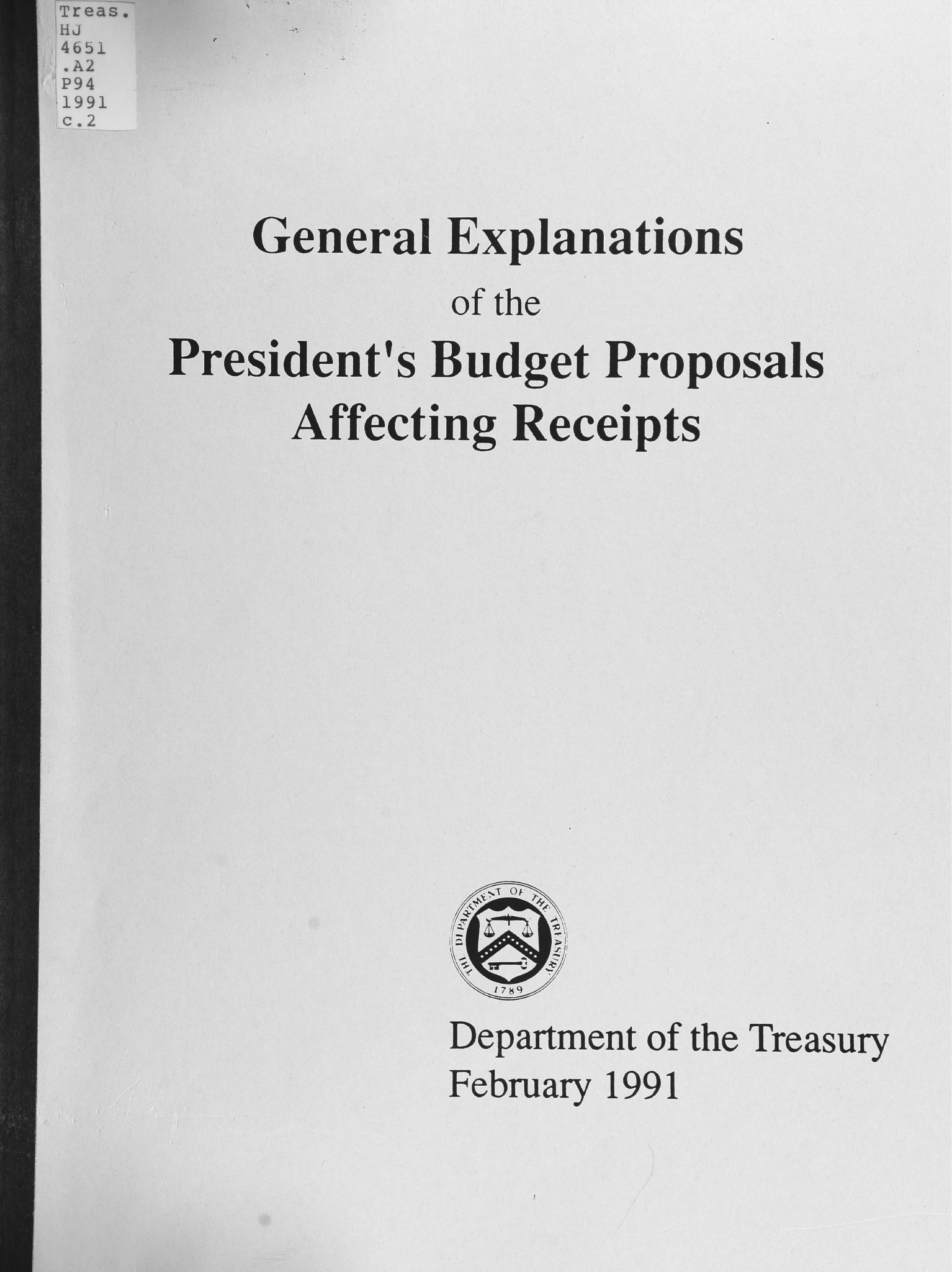
Treas.
HJ
4651
.A2
P94
1991
c. 2
General Explanations
of
the
President's Budget Proposals
Affecting Receipts
Department of the
Treasury
February
1991

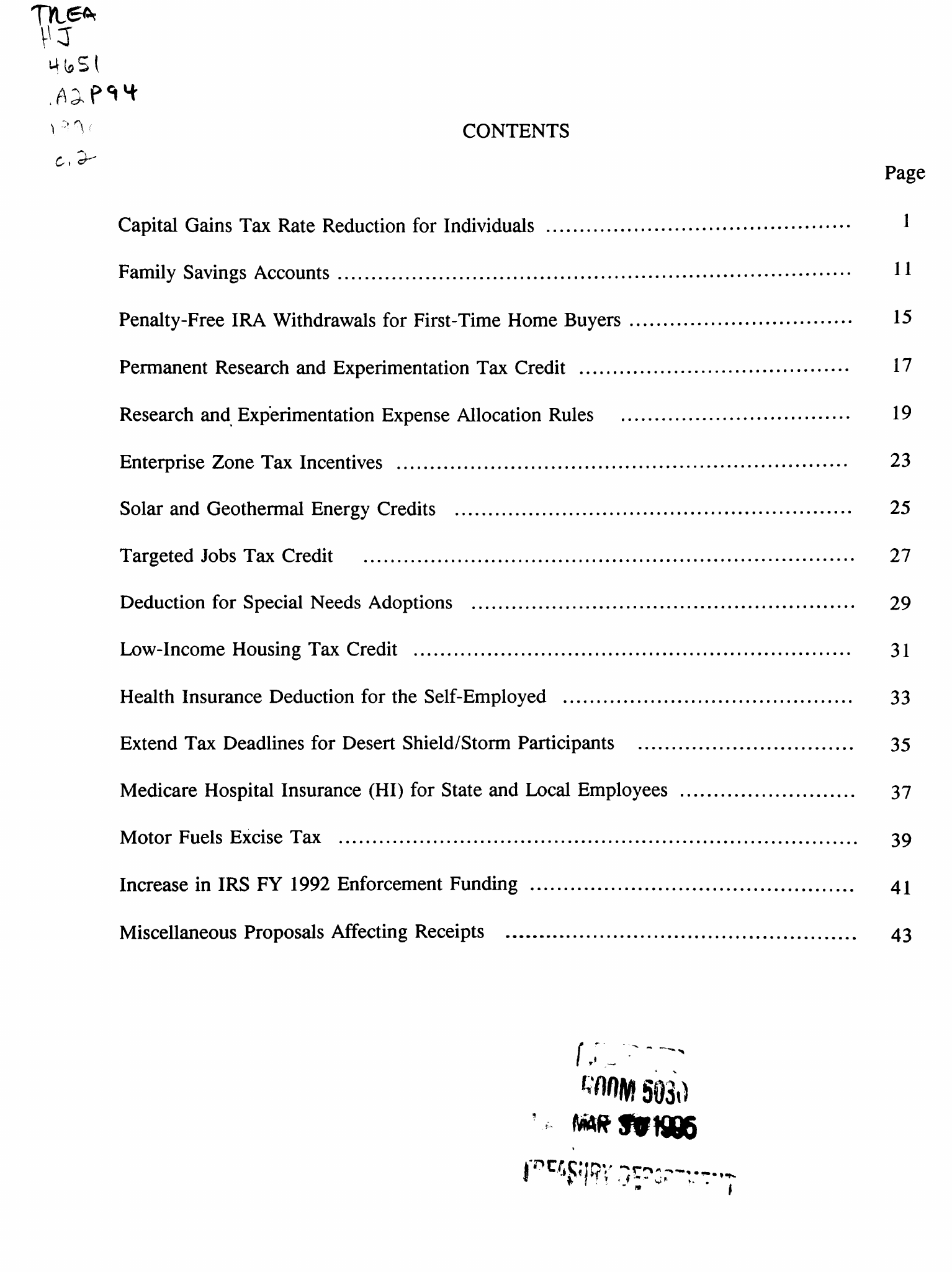
\
z>
^
CONTENTS
Pag
Capital Gains Tax Rate Reduction for Individuals *
Family Savings Accounts 11
Penalty-Free IRA Withdrawals for First-Time Home Buyers 15
Permanent Research and Experimentation Tax Credit 17
Research and Experimentation Expense Allocation Rules 19
Enterprise Zone Tax Incentives 23
Solar and Geothermal Energy Credits 25
Targeted Jobs Tax Credit 27
Deduction for Special Needs Adoptions 29
Low-Income Housing Tax Credit 31
Health Insurance Deduction for the Self-Employed 33
Extend Tax Deadlines for Desert Shield/Storm Participants 35
Medicare Hospital Insurance (HI) for State and Local Employees 37
Motor Fuels Excise Tax 39
Increase in IRS FY 1992 Enforcement Funding 41
Miscellaneous Proposals Affecting Receipts 43
^m 5030

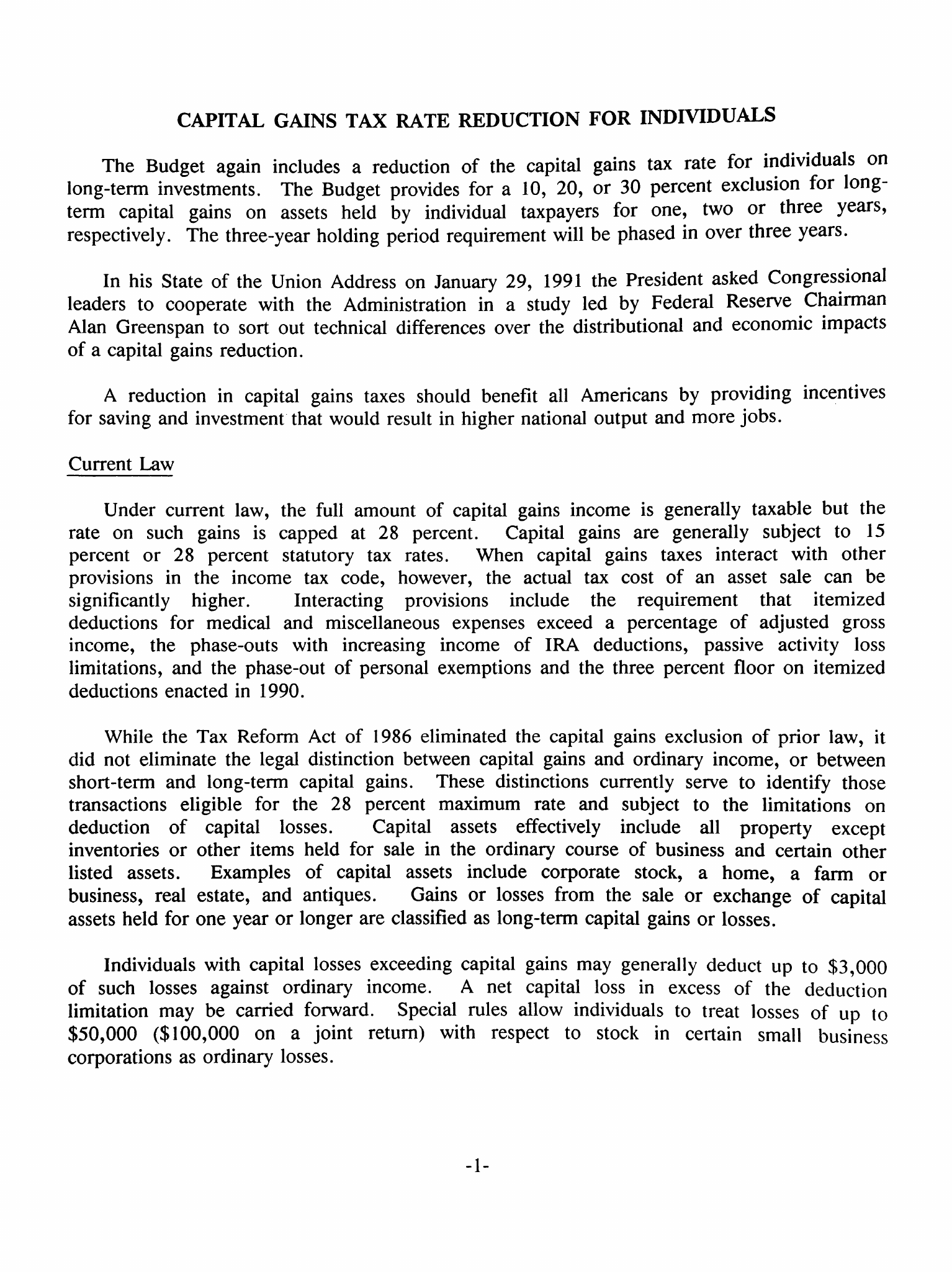
CAPITAL GAINS TAX RATE REDUCTION FOR INDIVIDUALS
The Budget again includes a reduction of the capital gains tax rate for individuals on
long-term investments. The Budget provides for
a
10, 20,
or 30
percent exclusion for long-
term capital gains
on
assets held
by
individual taxpayers
for
one,
two or
three years,
respectively. The three-year holding period requirement will be phased in over three years.
In his State of the Union Address on January 29, 1991 the President asked Congressional
leaders
to
cooperate with the Administration
in a
study
led by
Federal Reserve Chairman
Alan Greenspan to sort out technical differences over the distributional and economic impacts
of a capital gains reduction.
A reduction in capital gains taxes should benefit all Americans by providing incentives
for saving and investment that would result in higher national output and more
jobs.
Current Law
Under current law, the full amount of capital gains income is generally taxable but the
rate
on
such gains
is
capped
at 28
percent. Capital gains
are
generally subject
to 15
percent
or 28
percent statutory
tax
rates. When capital gains taxes interact with other
provisions
in the
income
tax
code, however,
the
actual
tax
cost
of an
asset sale
can be
significantly higher. Interacting provisions include
the
requirement that itemized
deductions
for
medical
and
miscellaneous expenses exceed
a
percentage
of
adjusted gross
income,
the
phase-outs with increasing income
of IRA
deductions, passive activity loss
limitations,
and the phase-out of personal exemptions and the three percent floor
on
itemized
deductions enacted in 1990.
While the Tax Reform Act of 1986 eliminated the capital gains exclusion of prior law, it
did not eliminate the legal distinction between capital gains and ordinary income,
or
between
short-term
and
long-term capital gains. These distinctions currently serve
to
identify those
transactions eligible
for the 28
percent maximum rate
and
subject
to the
limitations
on
deduction
of
capital losses. Capital assets effectively include
all
property except
inventories
or
other items held for sale
in
the ordinary course of business and certain other
listed assets. Examples
of
capital assets include corporate stock,
a
home,
a
farm
or
business,
real estate,
and
antiques. Gains
or
losses from the sale
or
exchange
of
capital
assets held for one year or longer are classified as long-term capital gains or losses.
Individuals with capital losses exceeding capital gains may generally deduct up to $3,000
of such losses against ordinary income.
A net
capital loss
in
excess
of the
deduction
limitation
may be
carried forward. Special rules allow individuals
to
treat losses
of up to
$50,000 ($100,000
on a
joint return) with respect
to
stock
in
certain small business
corporations as ordinary losses.
-1-
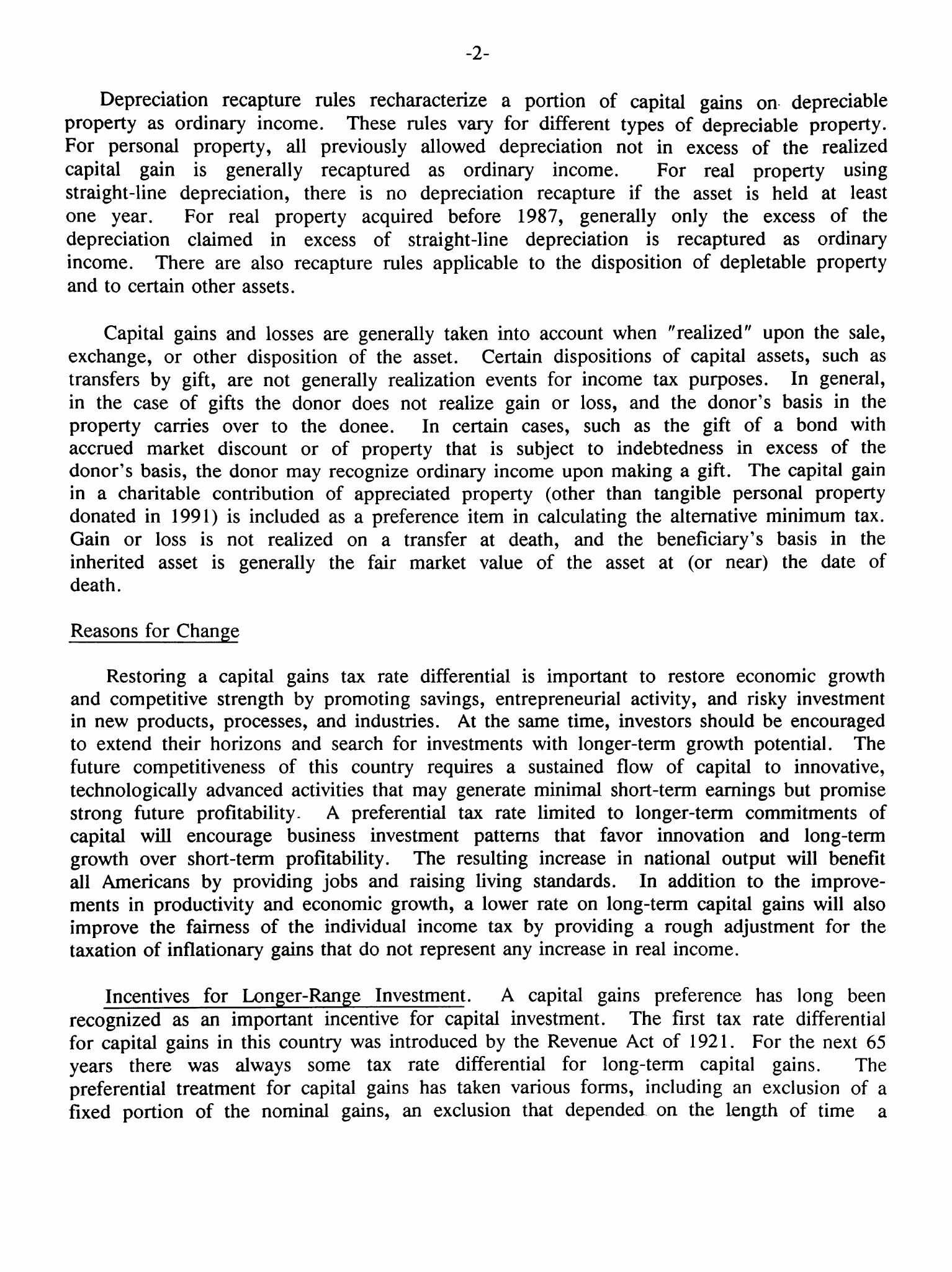
-2-
Depreciation recapture rules recharacterize a portion of capital gains on depreciable
property as ordinary income. These rules vary for different types of depreciable property.
For personal property, all previously allowed depreciation not in excess of the realized
capital gain is generally recaptured as ordinary income. For real property using
straight-line depreciation, there is no depreciation recapture if the asset is held at least
one year. For real property acquired before 1987, generally only the excess of the
depreciation claimed in excess of straight-line depreciation is recaptured as ordinary
income. There are also recapture rules applicable to the disposition of depletable property
and to certain other assets.
Capital gains and losses are generally taken into account when "realized" upon the sale,
exchange, or other disposition of the asset. Certain dispositions of capital assets, such as
transfers by gift, are not generally realization events for income tax purposes. In general,
in the case of gifts the donor does not realize gain or loss, and the donor's basis in the
property carries over to the donee. In certain cases, such as the gift of a bond with
accrued market discount or of property that is subject to indebtedness in excess of the
donor's basis, the donor may recognize ordinary income upon making a gift. The capital gain
in a charitable contribution of appreciated property (other than tangible personal property
donated in 1991) is included as a preference item in calculating the alternative minimum tax.
Gain or loss is not realized on a transfer at death, and the beneficiary's basis in the
inherited asset is generally the fair market value of the asset at (or near) the date of
death.
Reasons for Change
Restoring a capital gains tax rate differential is important to restore economic growth
and competitive strength by promoting savings, entrepreneurial activity, and risky investment
in new products, processes, and industries. At the same time, investors should be encouraged
to extend their horizons and search for investments with longer-term growth potential. The
future competitiveness of this country requires a sustained flow of capital to innovative,
technologically advanced activities that may generate minimal short-term earnings but promise
strong future profitability. A preferential tax rate limited to longer-term commitments of
capital will encourage business investment patterns that favor innovation and long-term
growth over short-term profitability. The resulting increase in national output will benefit
all Americans by providing jobs and raising living standards. In addition to the improve-
ments in productivity and economic growth, a lower rate on long-term capital gains will also
improve the fairness of the individual income tax by providing a rough adjustment for the
taxation of inflationary gains that do not represent any increase in real income.
Incentives for Longer-Range Investment. A capital gains preference has long been
recognized as an important incentive for capital investment. The first tax rate differential
for capital gains in this country was introduced by the Revenue Act of 1921. For the next 65
years there was always some tax rate differential for long-term capital gains. The
preferential treatment for capital gains has taken various forms, including an exclusion of a
fixed portion of the nominal gains, an exclusion that depended on the length of time a
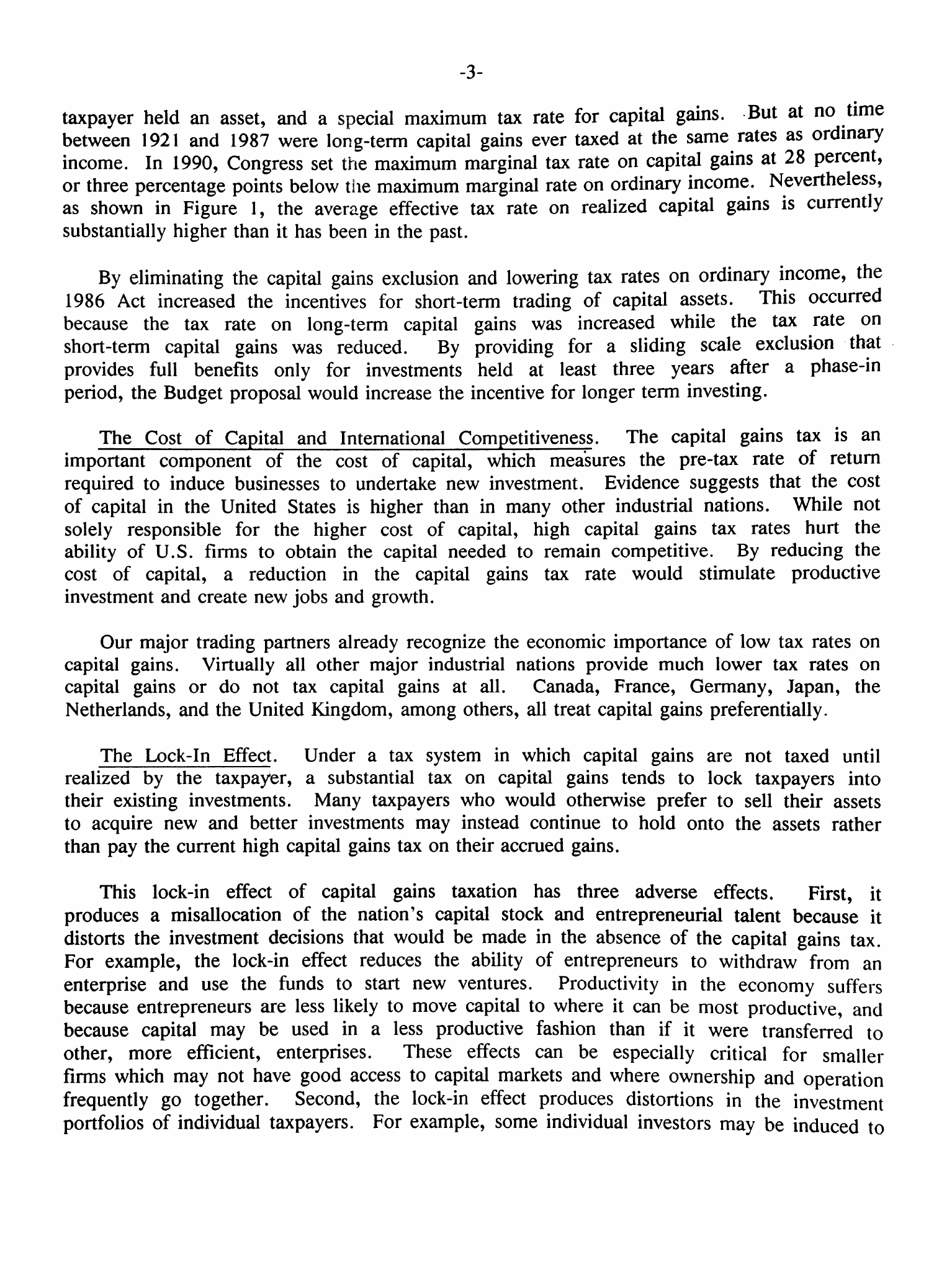
-3-
taxpayer held an asset, and a special maximum tax rate for capital gains. But at no time
between 1921 and 1987 were long-term capital gains ever taxed at the same rates as ordinary
income. In 1990, Congress set the maximum marginal tax rate on capital gains at 28 percent,
or three percentage points below the maximum marginal rate on ordinary income. Nevertheless,
as shown in Figure 1, the average effective tax rate on realized capital gains is currently
substantially higher than it has been in the past.
By eliminating the capital gains exclusion and lowering tax rates on ordinary income, the
1986 Act increased the incentives for short-term trading of capital assets. This occurred
because the tax rate on long-term capital gains was increased while the tax rate on
short-term capital gains was reduced. By providing for a sliding scale exclusion that
provides full benefits only for investments held at least three years after a phase-in
period, the Budget proposal would increase the incentive for longer term investing.
The Cost of Capital and International Competitiveness. The capital gains tax is an
important component of the cost of capital, which measures the pre-tax rate of return
required to induce businesses to undertake new investment. Evidence suggests that the cost
of capital in the United States is higher than in many other industrial nations. While not
solely responsible for the higher cost of capital, high capital gains tax rates hurt the
ability of U.S. firms to obtain the capital needed to remain competitive. By reducing the
cost of capital, a reduction in the capital gains tax rate would stimulate productive
investment and create new jobs and growth.
Our major trading partners already recognize the economic importance of low tax rates on
capital gains. Virtually all other major industrial nations provide much lower tax rates on
capital gains or do not tax capital gains at all. Canada, France, Germany, Japan, the
Netherlands, and the United Kingdom, among others, all treat capital gains preferentially.
The Lock-In Effect. Under a tax system in which capital gains are not taxed until
realized by the taxpayer, a substantial tax on capital gains tends to lock taxpayers into
their existing investments. Many taxpayers who would otherwise prefer to sell their assets
to acquire new and better investments may instead continue to hold onto the assets rather
than pay the current high capital gains tax on their accrued gains.
This lock-in effect of capital gains taxation has three adverse effects. First, it
produces a misallocation of the nation's capital stock and entrepreneurial talent because it
distorts the investment decisions that would be made in the absence of the capital gains tax.
For example, the lock-in effect reduces the ability of entrepreneurs to withdraw from an
enterprise and use the funds to start new ventures. Productivity in the economy suffers
because entrepreneurs are less likely to move capital to where it can be most productive, and
because capital may be used in a less productive fashion than if it were transferred to
other, more efficient, enterprises. These effects can be especially critical for smaller
firms which may not have good access to capital markets and where ownership and operation
frequently go together. Second, the lock-in effect produces distortions in the investment
portfolios of individual taxpayers. For example, some individual investors may be induced to
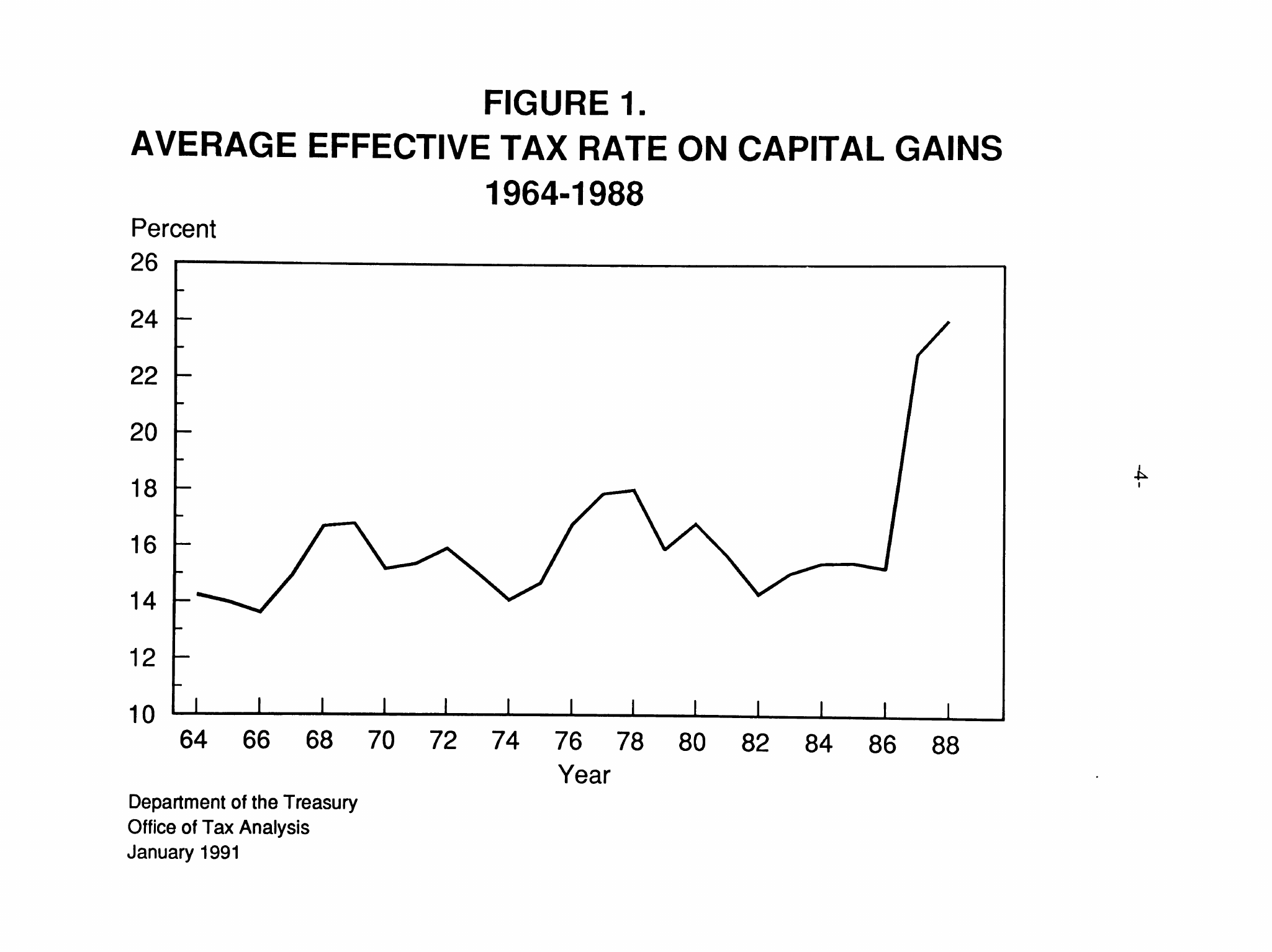
FIGURE 1.
AVERAGE EFFECTIVE TAX RATE ON CAPITAL GAINS
1964-1988
Percent
4
64 66 68 70 72 74
Department of the Treasury
Office of
Tax
Analysis
January
1991
76 78 80
Year
82 84 86 88
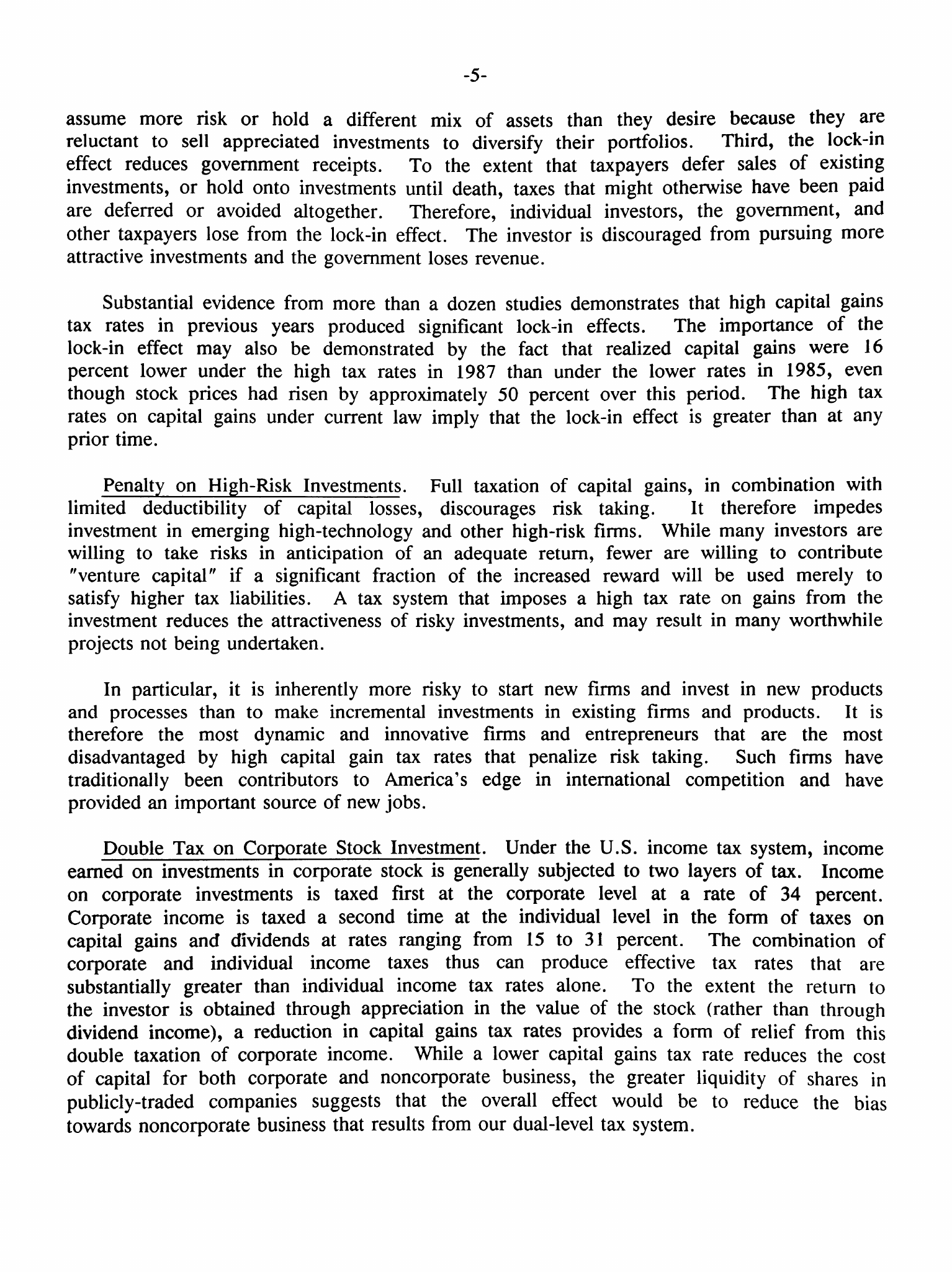
-5-
assume more risk or hold a different mix of assets than they desire because they are
reluctant to sell appreciated investments to diversify their portfolios. Third, the lock-in
effect reduces government receipts. To the extent that taxpayers defer sales of existing
investments, or hold onto investments until death, taxes that might otherwise have been paid
are deferred or avoided altogether. Therefore, individual investors, the government, and
other taxpayers lose from the lock-in effect. The investor is discouraged from pursuing more
attractive investments and the government loses revenue.
Substantial evidence from more than a dozen studies demonstrates that high capital gains
tax rates in previous years produced significant lock-in effects. The importance of the
lock-in effect may also be demonstrated by the fact that realized capital gains were 16
percent lower under the high tax rates in 1987 than under the lower rates in 1985, even
though stock prices had risen by approximately 50 percent over this period. The high tax
rates on capital gains under current law imply that the lock-in effect is greater than at any
prior time.
Penalty on High-Risk Investments. Full taxation of capital gains, in combination with
limited deductibility of capital losses, discourages risk taking. It therefore impedes
investment in emerging high-technology and other high-risk firms. While many investors are
willing to take risks in anticipation of an adequate return, fewer are willing to contribute
"venture capital" if a significant fraction of the increased reward will be used merely to
satisfy higher tax liabilities. A tax system that imposes a high tax rate on gains from the
investment reduces the attractiveness of risky investments, and may result in many worthwhile
projects not being undertaken.
In particular, it is inherently more risky to start new firms and invest in new products
and processes than to make incremental investments in existing firms and products. It is
therefore the most dynamic and innovative firms and entrepreneurs that are the most
disadvantaged by high capital gain tax rates that penalize risk taking. Such firms have
traditionally been contributors to America's edge in international competition and have
provided an important source of new jobs.
Double Tax on Corporate Stock Investment. Under the U.S. income tax system, income
earned on investments in corporate stock is generally subjected to two layers of tax. Income
on corporate investments is taxed first at the corporate level at a rate of 34 percent.
Corporate income is taxed a second time at the individual level in the form of taxes on
capital gains and dividends at rates ranging from 15 to 31 percent. The combination of
corporate and individual income taxes thus can produce effective tax rates that are
substantially greater than individual income tax rates alone. To the extent the return to
the investor is obtained through appreciation in the value of the stock (rather than through
dividend
income),
a reduction in capital gains tax rates provides a form of relief from this
double taxation of corporate income. While a lower capital gains tax rate reduces the cost
of capital for both corporate and noncorporate business, the greater liquidity of shares in
publicly-traded companies suggests that the overall effect would be to reduce the bias
towards noncorporate business that results from our dual-level tax system.
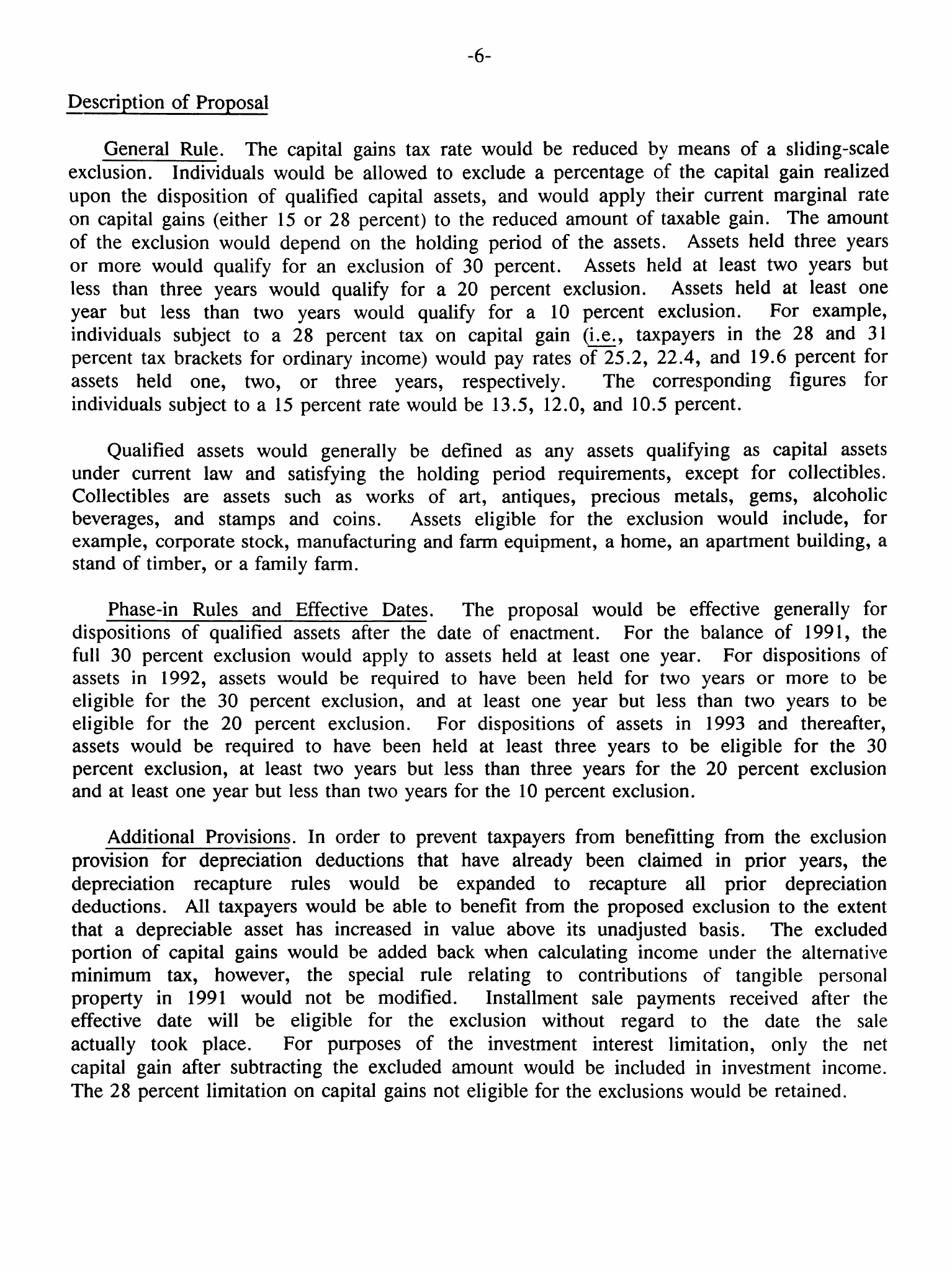
-6-
Description of Proposal
General Rule. The capital gains tax rate would be reduced by means of a sliding-scale
exclusion. Individuals would be allowed to exclude a percentage of the capital gain realized
upon the disposition of qualified capital assets, and would apply their current marginal rate
on capital gains (either 15 or 28 percent) to the reduced amount of taxable gain. The amount
of the exclusion would depend on the holding period of the assets. Assets held three years
or more would qualify for an exclusion of 30 percent. Assets held at least two years but
less than three years would qualify for a 20 percent exclusion. Assets held at least one
year but less than two years would qualify for a 10 percent exclusion. For example,
individuals subject to a 28 percent tax on capital gain (i.e., taxpayers in the 28 and 31
percent tax brackets for ordinary income) would pay rates of
25.2,
22.4, and 19.6 percent for
assets held one, two, or three years, respectively. The corresponding figures for
individuals subject to a 15 percent rate would be 13.5, 12.0, and 10.5 percent.
Qualified assets would generally be defined as any assets qualifying as capital assets
under current law and satisfying the holding period requirements, except for collectibles.
Collectibles are assets such as works of art, antiques, precious metals, gems, alcoholic
beverages,
and stamps and coins. Assets eligible for the exclusion would include, for
example, corporate stock, manufacturing and farm equipment, a home, an apartment building, a
stand of timber, or a family farm.
Phase-in Rules and Effective Dates. The proposal would be effective generally for
dispositions of qualified assets after the date of enactment. For the balance of 1991, the
full 30 percent exclusion would apply to assets held at least one year. For dispositions of
assets in 1992, assets would be required to have been held for two years or more to be
eligible for the 30 percent exclusion, and at least one year but less than two years to be
eligible for the 20 percent exclusion. For dispositions of assets in 1993 and thereafter,
assets would be required to have been held at least three years to be eligible for the 30
percent exclusion, at least two years but less than three years for the 20 percent exclusion
and at least one year but less than two years for the 10 percent exclusion.
Additional Provisions. In order to prevent taxpayers from benefitting from the exclusion
provision for depreciation deductions that have already been claimed in prior years, the
depreciation recapture rules would be expanded to recapture all prior depreciation
deductions. All taxpayers would be able to benefit from the proposed exclusion to the extent
that a depreciable asset has increased in value above its unadjusted basis. The excluded
portion of capital gains would be added back when calculating income under the alternative
minimum tax, however, the special rule relating to contributions of tangible personal
property in 1991 would not be modified. Installment sale payments received after the
effective date will be eligible for the exclusion without regard to the date the sale
actually took place. For purposes of the investment interest limitation, only the net
capital gain after subtracting the excluded amount would be included in investment income.
The 28 percent limitation on capital gains not eligible for the exclusions would be retained.
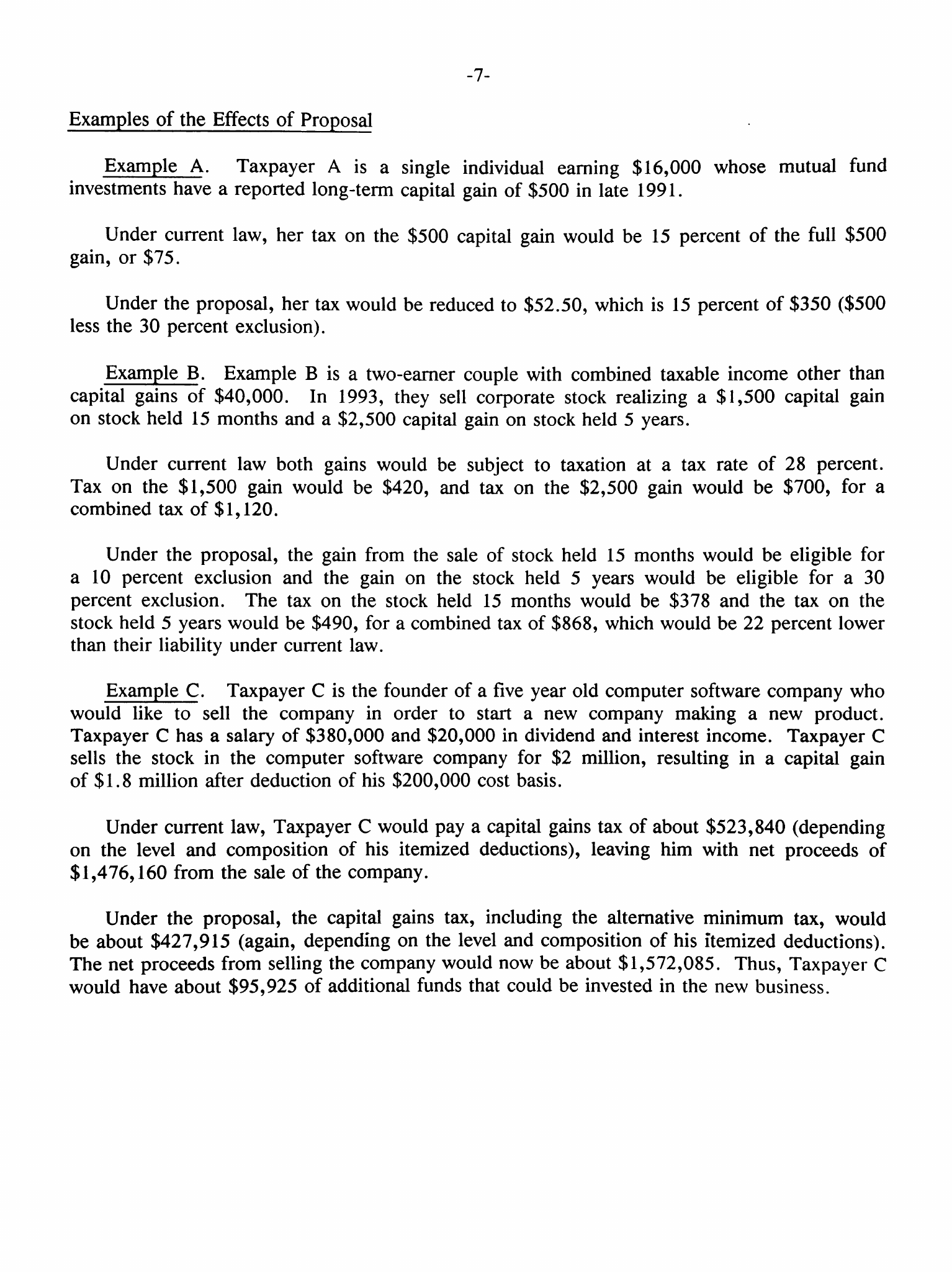
-7-
Examples of the Effects of Proposal
Example A. Taxpayer A is a single individual earning $16,000 whose mutual fund
investments have a reported long-term capital gain of $500 in late 1991.
Under current law, her tax on the $500 capital gain would be 15 percent of the full $500
gain, or $75.
Under the proposal, her tax would be reduced to $52.50, which is 15 percent of $350 ($500
less the 30 percent
exclusion).
Example B. Example B is a two-earner couple with combined taxable income other than
capital gains of $40,000. In 1993, they sell corporate stock realizing a $1,500 capital gain
on stock held 15 months and a $2,500 capital gain on stock held 5 years.
Under current law both gains would be subject to taxation at a tax rate of 28 percent.
Tax on the $1,500 gain would be
$420,
and tax on the $2,500 gain would be
$700,
for a
combined tax of $1,120.
Under the proposal, the gain from the sale of stock held 15 months would be eligible for
a 10 percent exclusion and the gain on the stock held 5 years would be eligible for a 30
percent exclusion. The tax on the stock held 15 months would be $378 and the tax on the
stock held 5 years would be
$490,
for a combined tax of
$868,
which would be 22 percent lower
than their liability under current law.
Example C. Taxpayer C is the founder of a five year old computer software company who
would like to sell the company in order to start a new company making a new product.
Taxpayer C has a salary of $380,000 and $20,000 in dividend and interest income. Taxpayer C
sells the stock in the computer software company for $2 million, resulting in a capital gain
of $1.8 million after deduction of his $200,000 cost basis.
Under current law, Taxpayer C would pay a capital gains tax of about $523,840 (depending
on the level and composition of his itemized
deductions),
leaving him with net proceeds of
$1,476,160 from the sale of the company.
Under the proposal, the capital gains tax, including the alternative minimum tax, would
be about $427,915 (again, depending on the level and composition of his itemized
deductions).
The net proceeds from selling the company would now be about $1,572,085. Thus, Taxpayer C
would have about $95,925 of additional funds that could be invested in the new business.
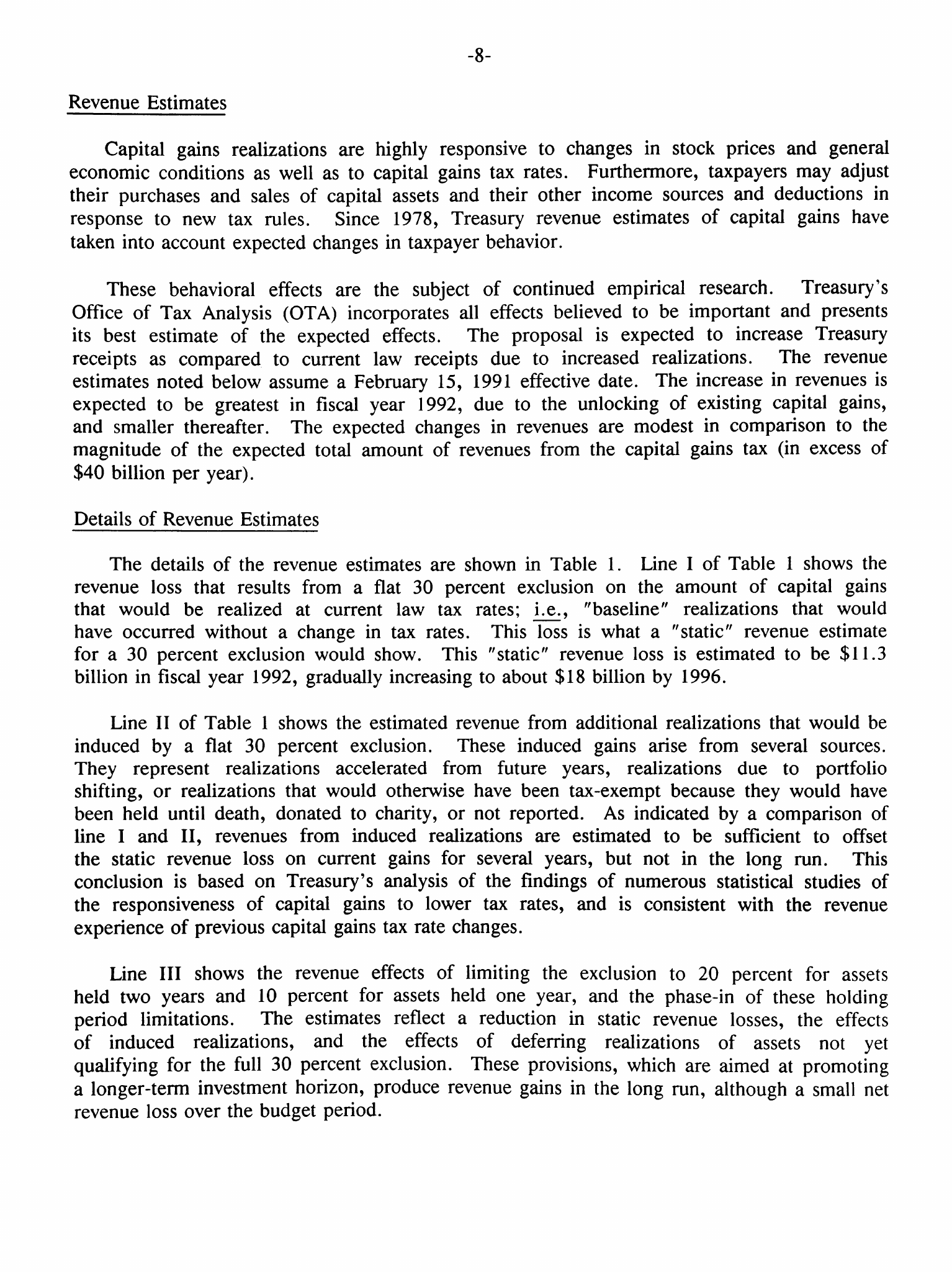
-8-
Revenue Estimates
Capital gains realizations are highly responsive to changes in stock prices and general
economic conditions as well as to capital gains tax rates. Furthermore, taxpayers may adjust
their purchases and sales of capital assets and their other income sources and deductions in
response to new tax rules. Since 1978, Treasury revenue estimates of capital gains have
taken into account expected changes in taxpayer behavior.
These behavioral effects are the subject of continued empirical research. Treasury's
Office of Tax Analysis (OTA) incorporates all effects believed to be important and presents
its best estimate of the expected effects. The proposal is expected to increase Treasury
receipts as compared to current law receipts due to increased realizations. The revenue
estimates noted below assume a February 15, 1991 effective date. The increase in revenues is
expected to be greatest in fiscal year 1992, due to the unlocking of existing capital gains,
and smaller thereafter. The expected changes in revenues are modest in comparison to the
magnitude of the expected total amount of revenues from the capital gains tax (in excess of
$40 billion per
year).
Details of Revenue Estimates
The details of the revenue estimates are shown in Table 1. Line I of Table 1 shows the
revenue loss that results from a flat 30 percent exclusion on the amount of capital gains
that would be realized at current law tax rates; Le., "baseline" realizations that would
have occurred without a change in tax rates. This loss is what a "static" revenue estimate
for a 30 percent exclusion would show. This "static" revenue loss is estimated to be $11.3
billion in fiscal year 1992, gradually increasing to about $18 billion by 1996.
Line II of Table 1 shows the estimated revenue from additional realizations that would be
induced by a flat 30 percent exclusion. These induced gains arise from several sources.
They represent realizations accelerated from future years, realizations due to portfolio
shifting, or realizations that would otherwise have been tax-exempt because they would have
been held until death, donated to charity, or not reported. As indicated by a comparison of
line I and II, revenues from induced realizations are estimated to be sufficient to offset
the static revenue loss on current gains for several years, but not in the long run. This
conclusion is based on Treasury's analysis of the findings of numerous statistical studies of
the responsiveness of capital gains to lower tax rates, and is consistent with the revenue
experience of previous capital gains tax rate changes.
Line III shows the revenue effects of limiting the exclusion to 20 percent for assets
held two years and 10 percent for assets held one year, and the phase-in of these holding
period limitations. The estimates reflect a reduction in static revenue losses, the effects
of induced realizations, and the effects of deferring realizations of assets not yet
qualifying for the full 30 percent exclusion. These provisions, which are aimed at promoting
a longer-term investment horizon, produce revenue gains in the long run, although a small net
revenue loss over the budget period.
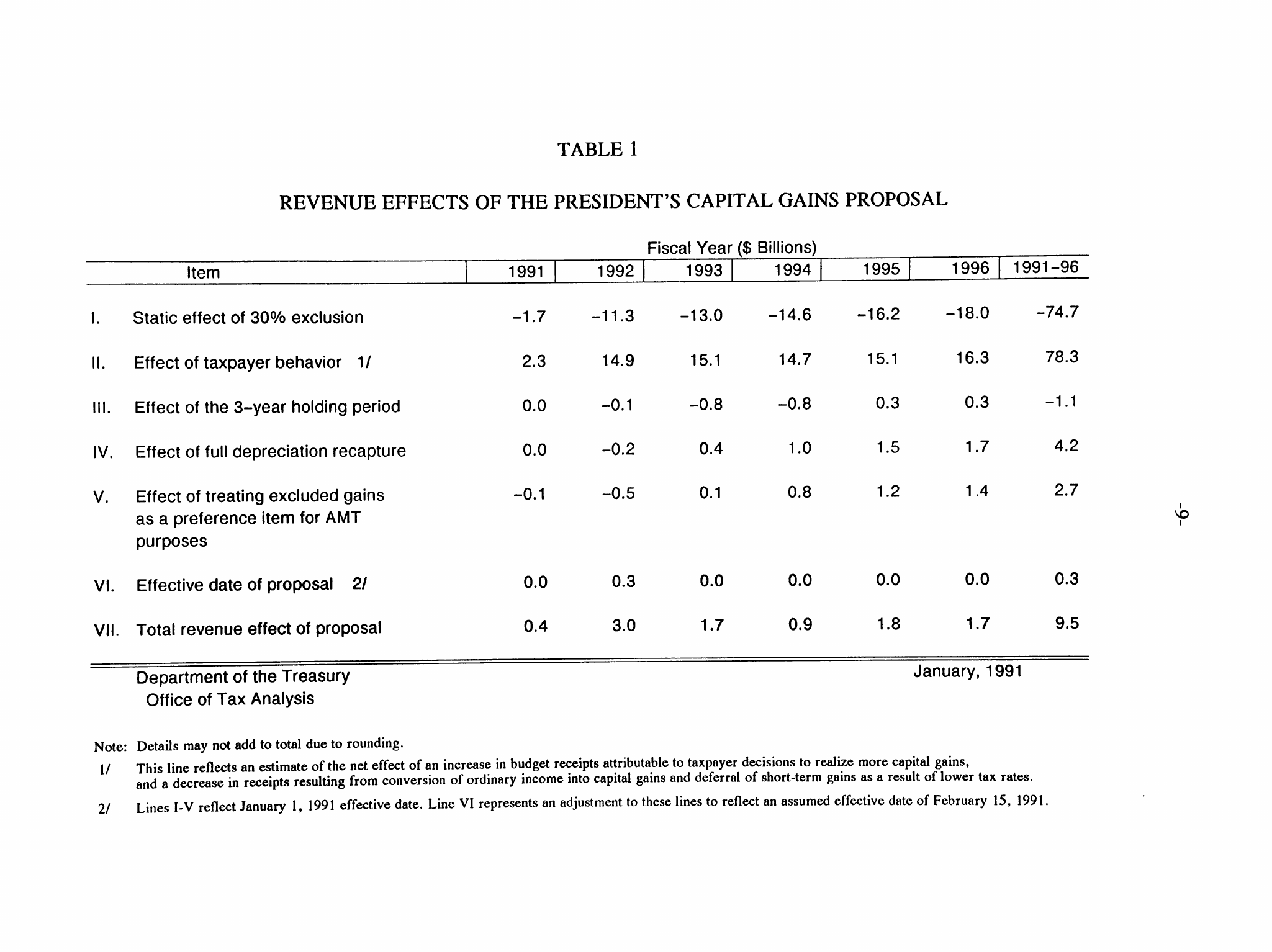
TABLE
1
REVENUE EFFECTS OF THE PRESIDENT'S CAPITAL
GAINS
PROPOSAL
Item
1991
Fiscal Year ($ Billions)
1992
1993
1994
1995
1996 1991-96
Static effect of 30% exclusion
11.
Effect of taxpayer behavior
1
/
III. Effect of the 3-year holding period
IV. Effect of full depreciation recapture
V. Effect of treating excluded gains
as
a
preference item for AMT
purposes
1.7
2.3
0.0
0.0
0.1
-11.3
14.9
-0.1
-0.2
-0.5
-13.0
15.1
-0.8
0.4
0.1
-14.6
14.7
-0.8
1.0
0.8
-16.2
15.1
0.3
1.5
1.2
-18.0
16.3
0.3
1.7
1.4
-74.7
78.3
-1.1
4.2
2.7
i
VI.
Effective date of proposal
2/
0.0
0.3
0.0
0.0
0.0
0.0
0.3
VII.
Total revenue effect of proposal
0.4
3.0
1.7
0.9
1.8
1.7
9.5
Department of the Treasury
Office of Tax Analysis
January, 1991
Note: Details
may
not add to total due to rounding.
1/ This line reflects
an
estimate of the net effect of an increase in budget receipts attributable to taxpayer decisions to realize more capital gains,
and
a
decrease in receipts resulting from conversion of ordinary income into capital gains and deferral of short-term gains as
a
result of lower tax rates.
2/ Lines I-V reflect January 1, 1991 effective date. Line VI represents an adjustment to these lines to reflect an assumed effective date of February 15, 1991
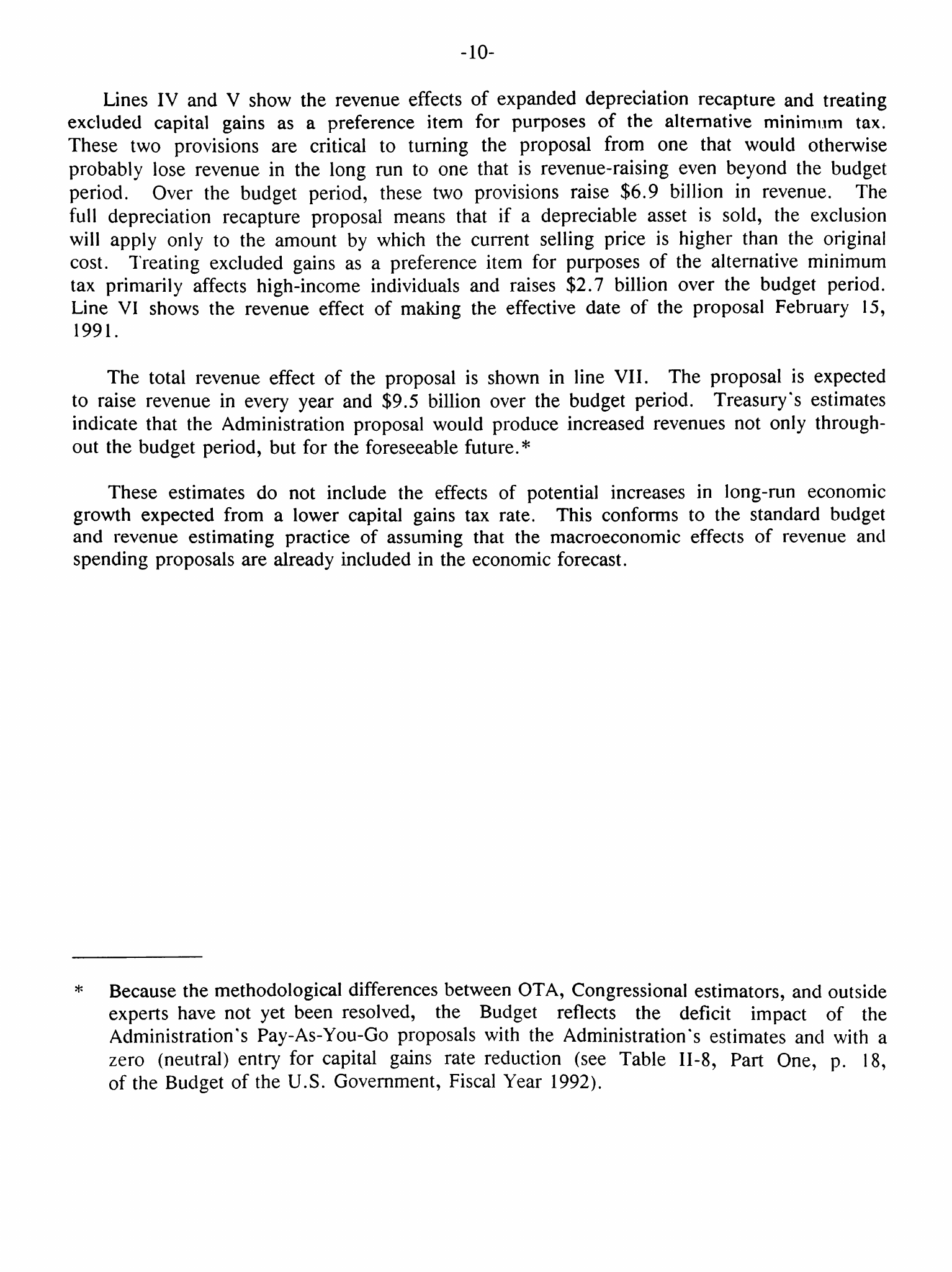
-10-
Lines IV and V show the revenue effects of expanded depreciation recapture and treating
excluded capital gains as a preference item for purposes of the alternative minimum tax.
These two provisions are critical to turning the proposal from one that would otherwise
probably lose revenue in the long run to one that is revenue-raising even beyond the budget
period. Over the budget period, these two provisions raise $6.9 billion in revenue. The
full depreciation recapture proposal means that if a depreciable asset is sold, the exclusion
will apply only to the amount by which the current selling price is higher than the original
cost. Treating excluded gains as a preference item for purposes of the alternative minimum
tax primarily affects high-income individuals and raises $2.7 billion over the budget period.
Line VI shows the revenue effect of making the effective date of the proposal February 15,
1991.
The total revenue effect of the proposal is shown in line VII. The proposal is expected
to raise revenue in every year and $9.5 billion over the budget period. Treasury's estimates
indicate that the Administration proposal would produce increased revenues not only through-
out the budget period, but for the foreseeable future.*
These estimates do not include the effects of potential increases in long-run economic
growth expected from a lower capital gains tax rate. This conforms to the standard budget
and revenue estimating practice of assuming that the macroeconomic effects of revenue and
spending proposals are already included in the economic forecast.
Because the methodological differences between OTA, Congressional estimators, and outside
experts have not yet been resolved, the Budget reflects the deficit impact of the
Administration's Pay-As-You-Go proposals with the Administration's estimates and with a
zero (neutral) entry for capital gains rate reduction (see Table II-8, Part One, p. 18,
of the Budget of the U.S. Government, Fiscal Year
1992).
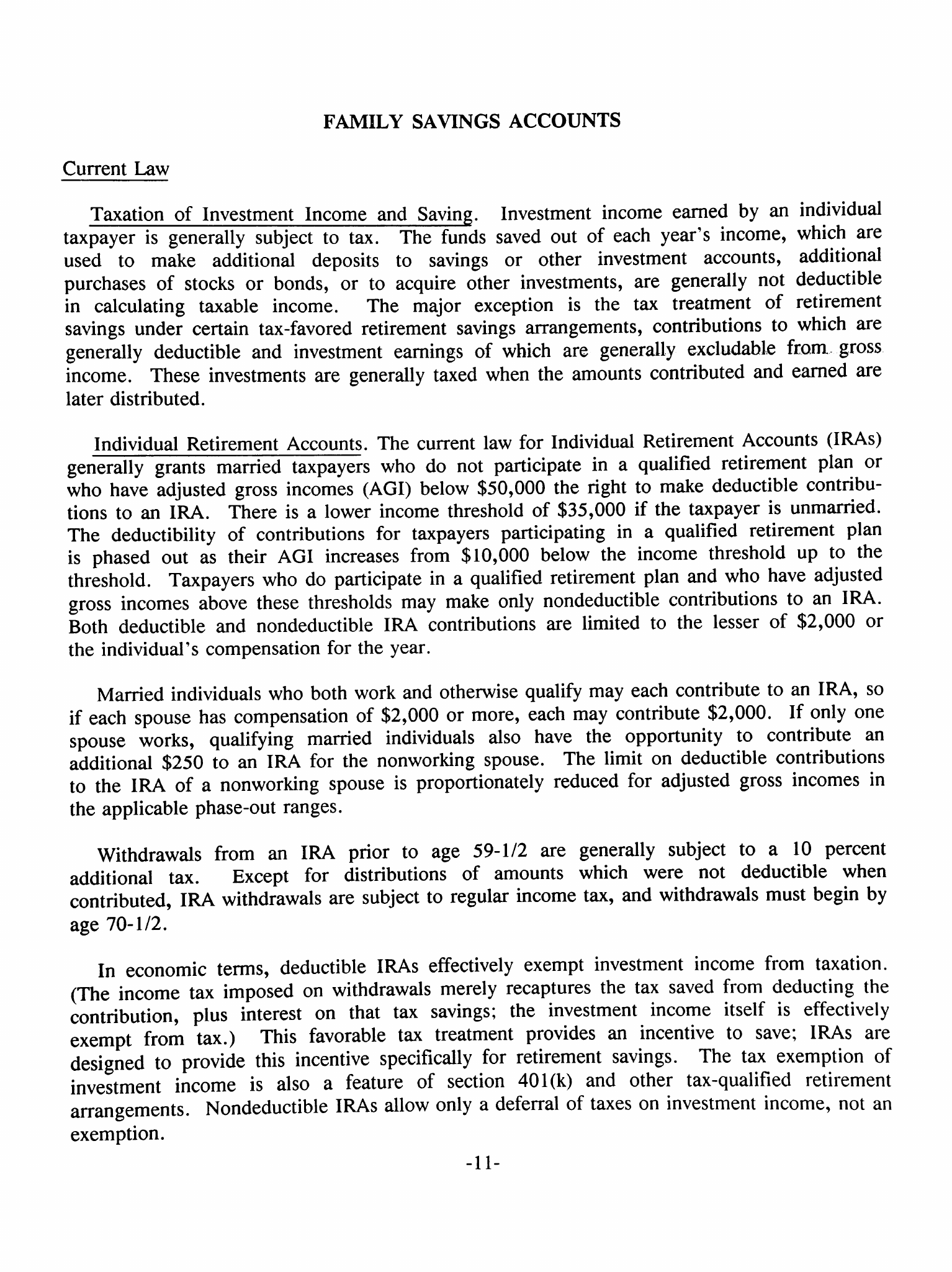
FAMILY SAVINGS ACCOUNTS
Current Law
Taxation of Investment Income and Saving. Investment income earned by an individual
taxpayer is generally subject
to
tax. The funds saved out of each year's income, which
are
used
to
make additional deposits
to
savings
or
other investment accounts, additional
purchases
of
stocks
or
bonds,
or to
acquire other investments, are generally not deductible
in calculating taxable income.
The
major exception
is the tax
treatment
of
retirement
savings under certain tax-favored retirement savings arrangements, contributions
to
which are
generally deductible
and
investment earnings
of
which are generally excludable from gross
income. These investments are generally taxed when the amounts contributed and earned are
later distributed.
Individual Retirement Accounts. The current law for Individual Retirement Accounts (IRAs)
generally grants married taxpayers
who do
not participate
in a
qualified retirement plan
or
who have adjusted gross incomes (AGI) below $50,000 the right to make deductible contribu-
tions to
an
IRA. There is
a
lower income threshold of $35,000 if the taxpayer is unmarried.
The deductibility
of
contributions for taxpayers participating
in a
qualified retirement plan
is phased out
as
their AGI increases from $10,000 below the income threshold
up to the
threshold. Taxpayers who
do
participate in
a
qualified retirement plan and who have adjusted
gross incomes above these thresholds may make only nondeductible contributions to
an
IRA.
Both deductible
and
nondeductible
IRA
contributions are limited
to
the lesser
of
$2,000
or
the individual's compensation for the year.
Married individuals who both work and otherwise qualify may each contribute to an IRA, so
if each spouse has compensation of $2,000 or more, each may contribute
$2,000.
If only one
spouse works, qualifying married individuals also have
the
opportunity
to
contribute
an
additional $250 to
an
IRA for the nonworking spouse. The limit
on
deductible contributions
to the IRA of
a
nonworking spouse is proportionately reduced for adjusted gross incomes
in
the applicable phase-out ranges.
Withdrawals from an IRA prior to age 59-1/2 are generally subject to a 10 percent
additional tax. Except
for
distributions
of
amounts which were
not
deductible when
contributed, IRA withdrawals are subject to regular income
tax,
and withdrawals must begin
by
age
70-1/2.
In economic terms, deductible IRAs effectively exempt investment income from taxation.
(The income tax imposed
on
withdrawals merely recaptures the tax saved from deducting the
contribution, plus interest
on
that
tax
savings;
the
investment income itself
is
effectively
exempt from tax.) This favorable
tax
treatment provides
an
incentive
to
save; IRAs
are
designed
to
provide this incentive specifically for retirement savings. The tax exemption
of
investment income
is
also
a
feature
of
section 401(k)
and
other tax-qualified retirement
arrangements. Nondeductible IRAs allow only
a
deferral of taxes on investment income, not
an
exemption.
-11-
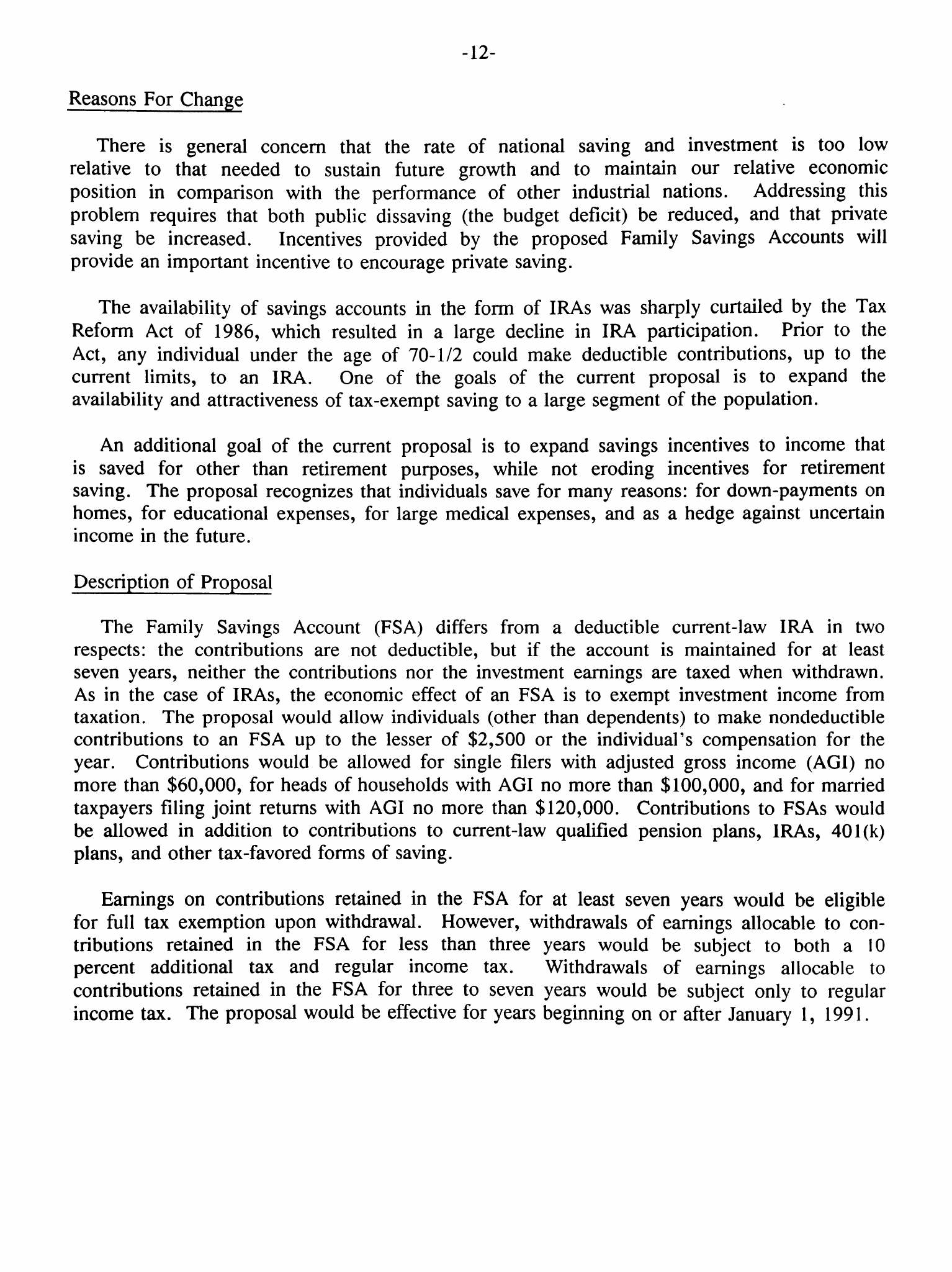
-12-
Reasons For Change
There is general concern that the rate of national saving and investment is too low
relative to that needed to sustain future growth and to maintain our relative economic
position in comparison with the performance of other industrial nations. Addressing this
problem requires that both public dissaving (the budget deficit) be reduced, and that private
saving be increased. Incentives provided by the proposed Family Savings Accounts will
provide an important incentive to encourage private saving.
The availability of savings accounts in the form of IRAs was sharply curtailed by the Tax
Reform Act of 1986, which resulted in a large decline in IRA participation. Prior to the
Act, any individual under the age of 70-1/2 could make deductible contributions, up to the
current limits, to an IRA. One of the goals of the current proposal is to expand the
availability and attractiveness of tax-exempt saving to a large segment of the population.
An additional goal of the current proposal is to expand savings incentives to income that
is saved for other than retirement purposes, while not eroding incentives for retirement
saving. The proposal recognizes that individuals save for many reasons: for down-payments on
homes,
for educational expenses, for large medical expenses, and as a hedge against uncertain
income in the future.
Description of Proposal
The Family Savings Account (FSA) differs from a deductible current-law IRA in two
respects:
the contributions are not deductible, but if the account is maintained for at least
seven years, neither the contributions nor the investment earnings are taxed when withdrawn.
As in the case of IRAs, the economic effect of an FSA is to exempt investment income from
taxation. The proposal would allow individuals (other than dependents) to make nondeductible
contributions to an FSA up to the lesser of $2,500 or the individual's compensation for the
year.
Contributions would be allowed for single filers with adjusted gross income (AGI) no
more than $60,000, for heads of households with AGI no more than $100,000, and for married
taxpayers
filing
joint returns with AGI no more than $120,000. Contributions to FSAs would
be allowed in addition to contributions to current-law qualified pension plans, IRAs, 401(k)
plans,
and other tax-favored forms of saving.
Earnings on contributions retained in the FSA for at least seven years would be eligible
for full tax exemption upon withdrawal. However, withdrawals of earnings allocable to con-
tributions retained in the FSA for less than three years would be subject to both a 10
percent additional tax and regular income tax. Withdrawals of earnings allocable to
contributions retained in the FSA for three to seven years would be subject only to regular
income tax. The proposal would be effective for years beginning on or after January 1, 1991.
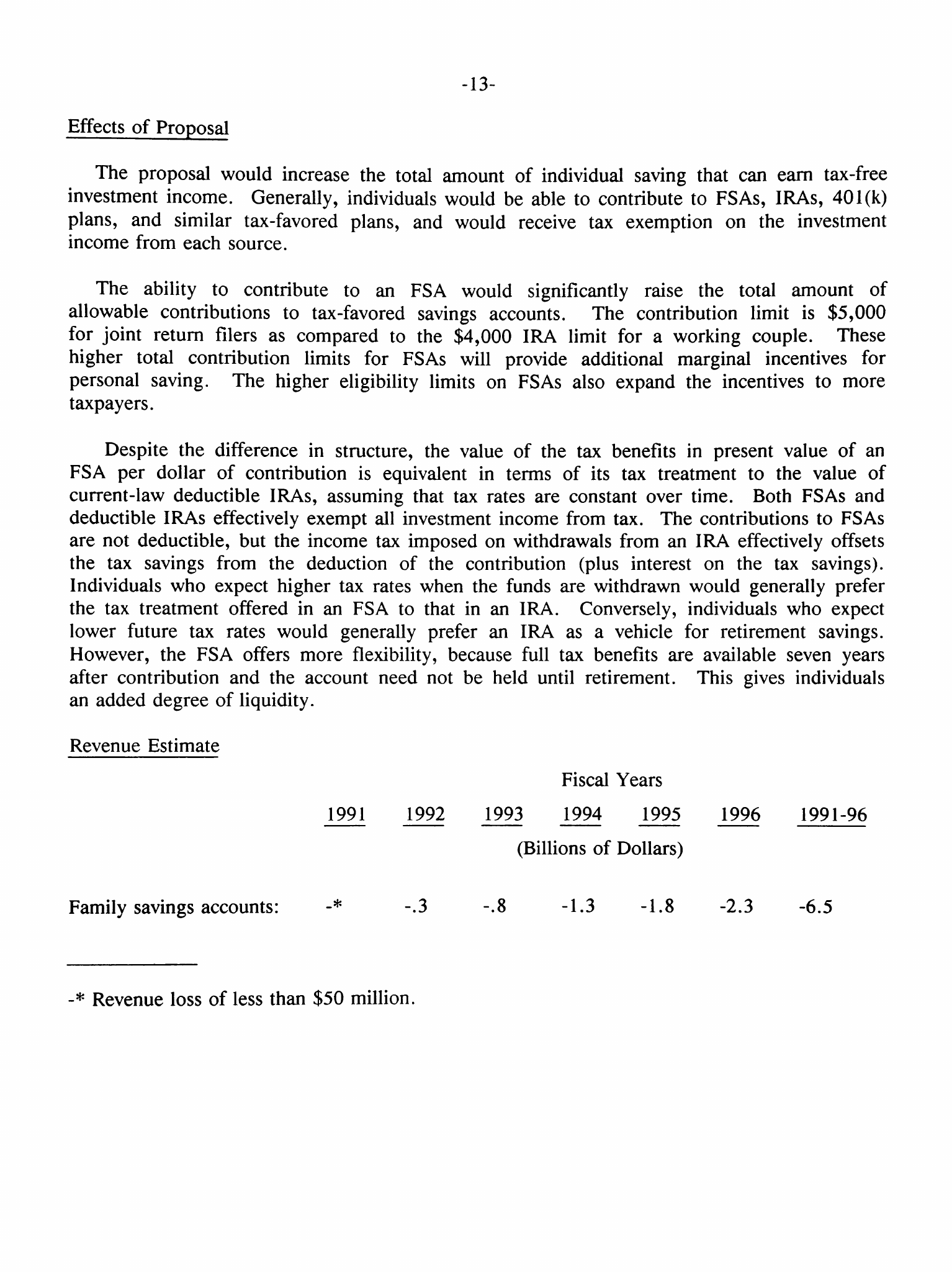
-13-
Effects of Proposal
The proposal would increase the total amount of individual saving that can earn tax-free
investment income. Generally, individuals would be able to contribute to FSAs, IRAs, 401(k)
plans,
and similar tax-favored plans, and would receive tax exemption on the investment
income from each source.
The ability to contribute to an FSA would significantly raise the total amount of
allowable contributions to tax-favored savings accounts. The contribution limit is $5,000
for joint return filers as compared to the $4,000 IRA limit for a working couple. These
higher total contribution limits for FSAs will provide additional marginal incentives for
personal saving. The higher eligibility limits on FSAs also expand the incentives to more
taxpayers.
Despite the difference in structure, the value of the tax benefits in present value of an
FSA per dollar of contribution is equivalent in terms of its tax treatment to the value of
current-law deductible IRAs, assuming that tax rates are constant over time. Both FSAs and
deductible IRAs effectively exempt all investment income from tax. The contributions to FSAs
are not deductible, but the income tax imposed on withdrawals from an IRA effectively offsets
the tax savings from the deduction of the contribution (plus interest on the tax
savings).
Individuals who expect higher tax rates when the funds are withdrawn would generally prefer
the tax treatment offered in an FSA to that in an IRA. Conversely, individuals who expect
lower future tax rates would generally prefer an IRA as a vehicle for retirement savings.
However, the FSA offers more flexibility, because full tax benefits are available seven years
after contribution and the account need not be held until retirement. This gives individuals
an added degree of liquidity.
Revenue Estimate
Fiscal Years
1991 1992 1993 1994 1995 1996 1991-96
(Billions of Dollars)
Family savings accounts: -* -.3 -.8 -1.3 -1.8 -2.3 -6.5
-* Revenue loss of less than $50 million.

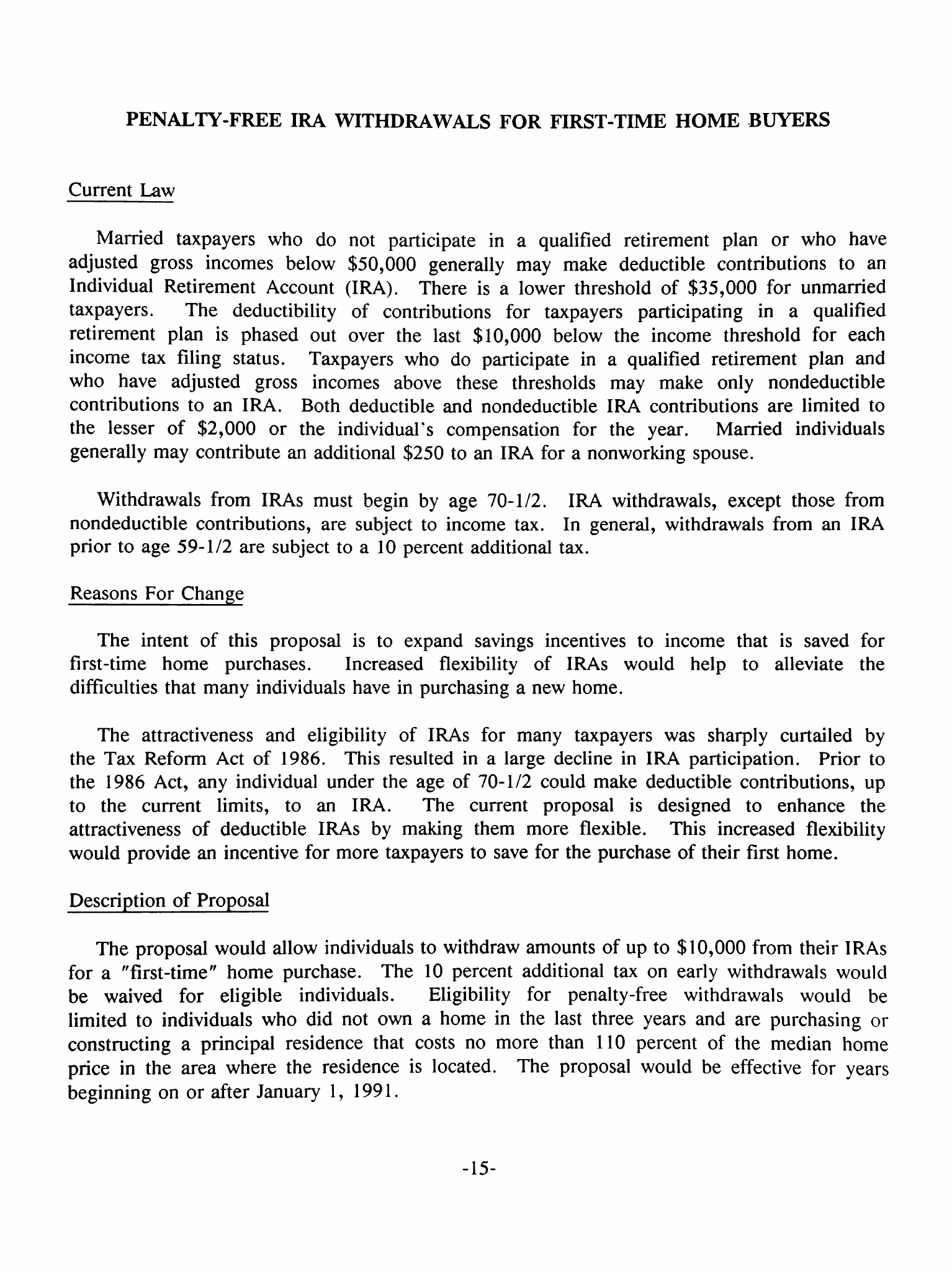
PENALTY-FREE IRA WITHDRAWALS FOR FIRST-TIME HOME BUYERS
Current Law
Married taxpayers who do not participate in a qualified retirement plan or who have
adjusted gross incomes below $50,000 generally
may
make deductible contributions
to an
Individual Retirement Account
(IRA).
There is
a
lower threshold
of
$35,000 for unmarried
taxpayers.
The
deductibility
of
contributions
for
taxpayers participating
in a
qualified
retirement plan
is
phased
out
over the last $10,000 below the income threshold
for
each
income tax filing status. Taxpayers
who do
participate
in a
qualified retirement plan
and
who have adjusted gross incomes above these thresholds
may
make only nondeductible
contributions to
an
IRA. Both deductible and nondeductible IRA contributions are limited
to
the lesser
of
$2,000
or the
individual's compensation
for the
year. Married individuals
generally may contribute an additional $250 to an IRA for
a
nonworking spouse.
Withdrawals from IRAs must begin by age 70-1/2. IRA withdrawals, except those from
nondeductible contributions, are subject to income tax.
In
general, withdrawals from
an IRA
prior to age 59-1/2 are subject to
a
10 percent additional tax.
Reasons For Change
The intent of this proposal is to expand savings incentives to income that is saved for
first-time home purchases. Increased flexibility
of
IRAs would help
to
alleviate
the
difficulties that many individuals have in purchasing
a
new home.
The attractiveness and eligibility of IRAs for many taxpayers was sharply curtailed by
the Tax Reform Act
of
1986. This resulted in
a
large decline in IRA participation. Prior
to
the 1986 Act, any individual under the age of 70-1/2 could make deductible contributions,
up
to
the
current limits,
to an IRA. The
current proposal
is
designed
to
enhance
the
attractiveness
of
deductible IRAs
by
making them more flexible. This increased flexibility
would provide an incentive for more taxpayers to save for the purchase of their
first
home.
Description of Proposal
The proposal would allow individuals to withdraw amounts of up to $10,000 from their IRAs
for
a
"first-time" home purchase.
The 10
percent additional tax
on
early withdrawals would
be waived
for
eligible individuals. Eligibility
for
penalty-free withdrawals would
be
limited to individuals who did not own
a
home in the last three years and are purchasing
or
constructing
a
principal residence that costs
no
more than 110 percent
of
the median home
price
in
the area where the residence is located. The proposal would
be
effective for years
beginning on or after January 1, 1991.
-15-
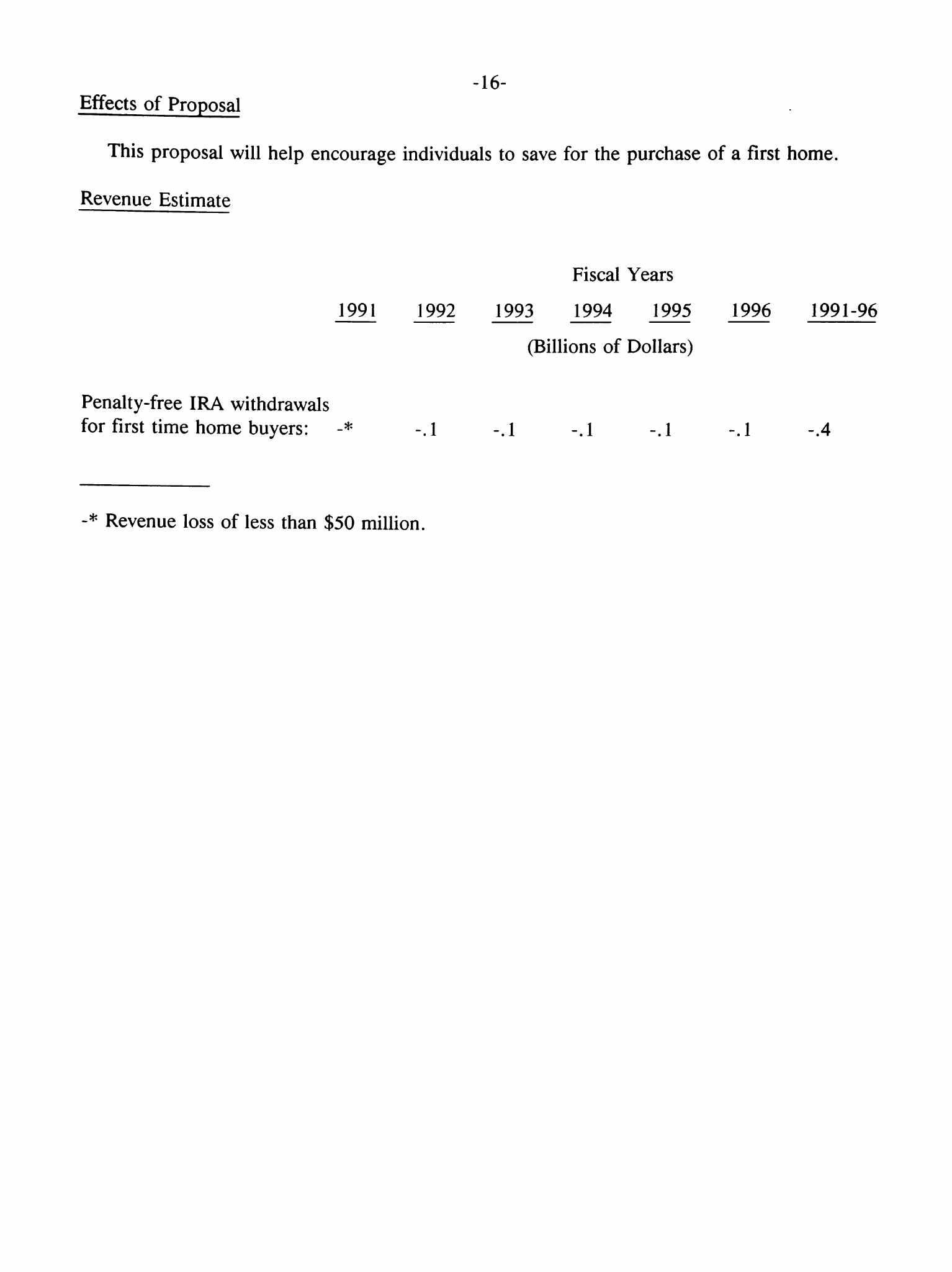
-16-
Effects of Proposal
This proposal will help encourage individuals to save for the purchase of a
first
home.
Revenue Estimate
Fiscal Years
1991 1992 1993 1994 1995 1996 1991-96
(Billions of Dollars)
Penalty-free IRA withdrawals
for
first
time home buyers: -* -.1 -.1 -.1 -.1 -.1 -.4
-* Revenue loss of less than $50 million.
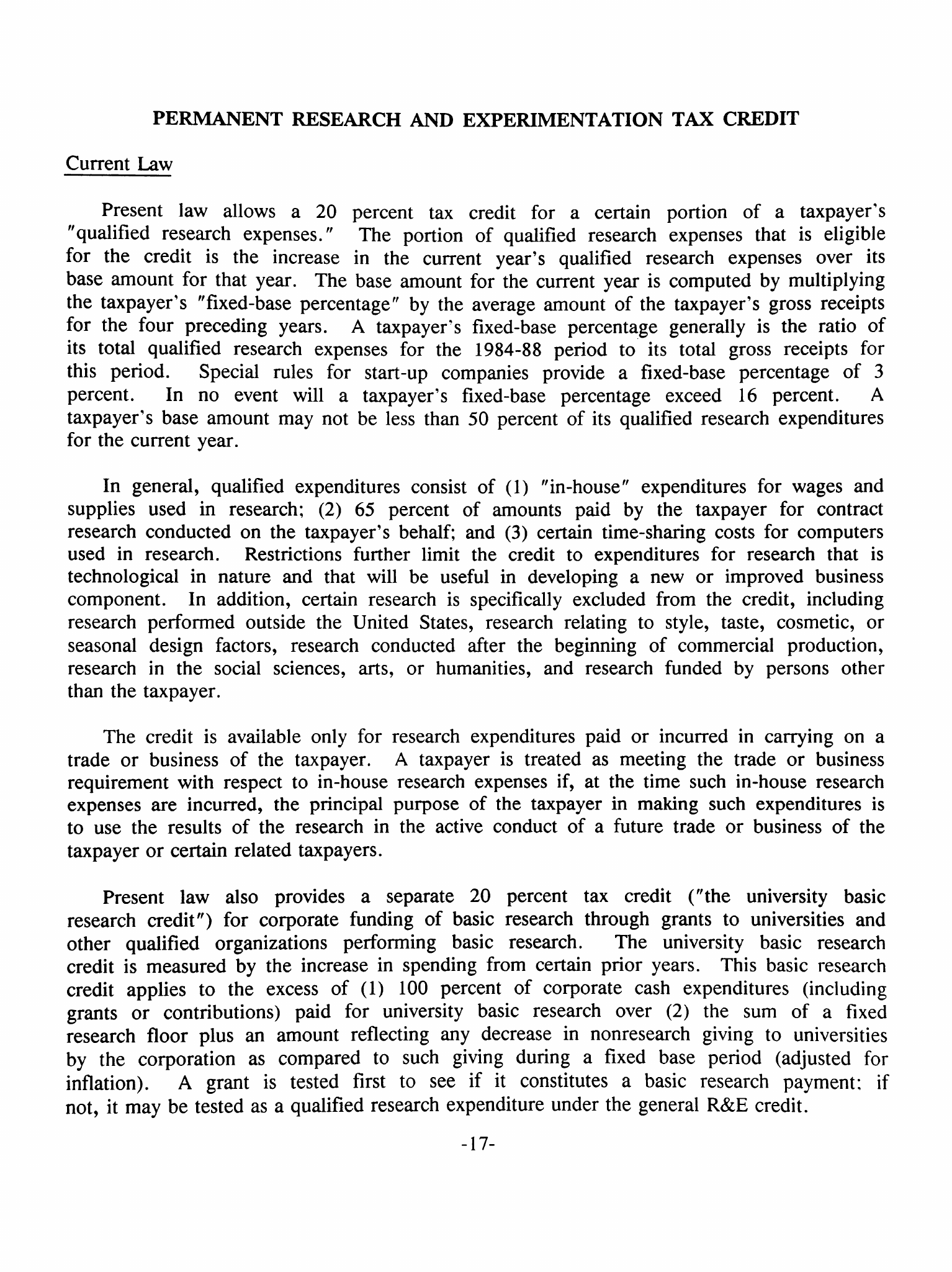
PERMANENT RESEARCH AND EXPERIMENTATION TAX CREDIT
Current Law
Present law allows a 20 percent tax credit for a certain portion of a taxpayer's
"qualified research expenses."
The
portion
of
qualified research expenses that
is
eligible
for
the
credit
is the
increase
in the
current year's qualified research expenses over
its
base amount for that year. The base amount for the current year is computed
by
multiplying
the taxpayer's "fixed-base percentage"
by
the average amount of the taxpayer's gross receipts
for the four preceding years.
A
taxpayer's fixed-base percentage generally
is
the ratio
of
its total qualified research expenses for the 1984-88 period
to
its total gross receipts
for
this period. Special rules
for
start-up companies provide
a
fixed-base percentage
of 3
percent.
In no
event will
a
taxpayer's fixed-base percentage exceed
16
percent.
A
taxpayer's base amount may not be less than 50 percent of its qualified research expenditures
for the current year.
In general, qualified expenditures consist of (1) "in-house" expenditures for wages and
supplies used
in
research; (2)
65
percent
of
amounts paid
by the
taxpayer
for
contract
research conducted
on
the taxpayer's behalf; and (3) certain time-sharing costs for computers
used
in
research. Restrictions further limit the credit
to
expenditures for research that
is
technological
in
nature
and
that will
be
useful
in
developing
a new or
improved business
component.
In
addition, certain research is specifically excluded from the credit, including
research performed outside the United States, research relating
to
style, taste, cosmetic,
or
seasonal design factors, research conducted after the beginning
of
commercial production,
research
in
the social sciences,
arts,
or
humanities,
and
research funded
by
persons other
than the taxpayer.
The credit is available only for research expenditures paid or incurred in carrying on a
trade
or
business
of
the taxpayer.
A
taxpayer is treated
as
meeting the trade
or
business
requirement with respect to in-house research expenses if, at the time such in-house research
expenses are incurred, the principal purpose of the taxpayer in making such expenditures
is
to use the results of the research
in
the active conduct of
a
future trade
or
business
of
the
taxpayer or certain related taxpayers.
Present law also provides a separate 20 percent tax credit ("the university basic
research credit") for corporate funding
of
basic research through grants
to
universities
and
other qualified organizations performing basic research.
The
university basic research
credit is measured
by
the increase in spending from certain prior years. This basic research
credit applies
to the
excess
of
(1)
100
percent
of
corporate cash expenditures (including
grants
or
contributions) paid
for
university basic research over (2)
the sum of a
fixed
research floor plus
an
amount reflecting
any
decrease
in
nonresearch giving
to
universities
by
the
corporation
as
compared
to
such giving during
a
fixed base period (adjusted
for
inflation).
A
grant
is
tested first
to see if it
constitutes
a
basic research payment:
if
not,
it may be tested as
a
qualified research expenditure under the general R&E credit.
-17-

-18-
The R&E credit is aggregated with certain other business credits and made subject to a
limitation based on tax liability. The sum of these credits may reduce the first $25,000 of
regular tax liability without limitation, but may offset only 75 percent of any additional
tax liability. Taxpayers may carry credits not usable in the current year back three years
and forward 15 years.
The amount of any deduction for research expenses is reduced by the amount of the tax
credit taken for that year.
The R&E credit in the form described above is in effect for taxable years beginning after
December 31, 1989. However, the credit will not apply to amounts paid or incurred after
December 31, 1991.
Reasons for Change
The current law tax credit for research provides an incentive for technological
innovation. Although the benefit to the country from such innovation is unquestioned, the
market rewards to those who take the risk of research and experimentation may not be
sufficient to support the level of research activity that is socially desirable. The credit
is intended to reward those engaged in research and experimentation of unproven technologies.
The credit cannot induce additional R&E expenditures unless its future availability is
known at the time firms are planning R&E projects and projecting costs. R&E activity, by its
nature, is long-term, and taxpayers should be able to plan their research activity knowing
that the credit will be available when the research is actually undertaken. Thus, if the R&E
credit is to have the intended incentive effect, it should be made permanent.
Description of Proposal
The R&E credit would be made permanent.
Effects of Proposal
Stable tax laws that encourage research allow taxpayers to undertake research with
greater assurance of the future tax consequences. A permanent R&E credit (including the
university basic research credit) permits taxpayers to establish and expand research
activities without fear that the tax incentive would not be available when the research is
carried out.
Revenue Estimate
Fiscal Years
1991 1992 1993 1994 1995 1996 1991-96
(Billions of Dollars)
Permanent R&E tax credit: 0 -0.5 -1.0 -1.3 -1.6 -1.8 -6.2
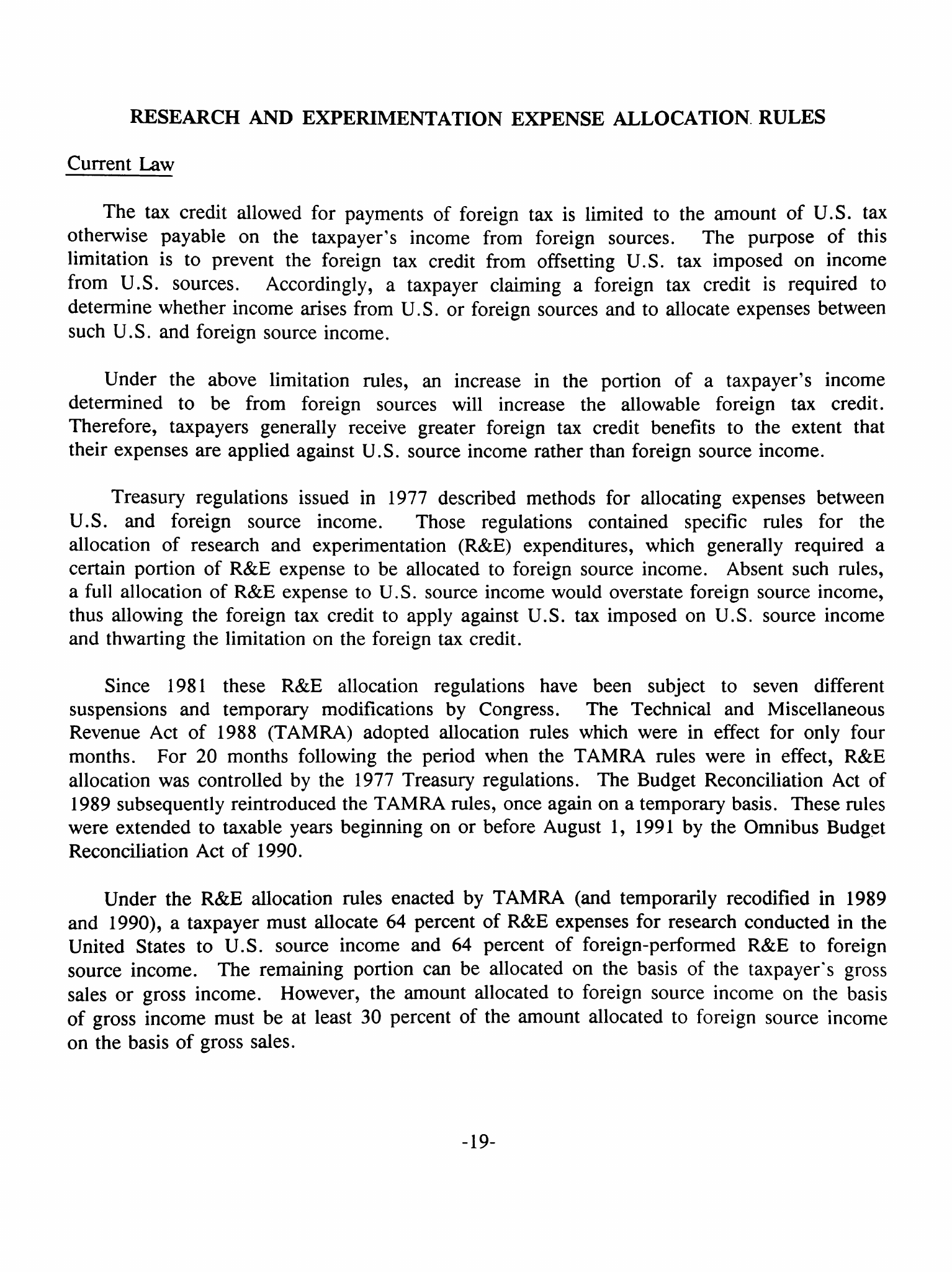
RESEARCH AND EXPERIMENTATION EXPENSE ALLOCATION RULES
Current Law
The tax credit allowed for payments of foreign tax is limited to the amount of U.S. tax
otherwise payable
on the
taxpayer's income from foreign sources.
The
purpose
of
this
limitation
is to
prevent the foreign
tax
credit from offsetting U.S. tax imposed
on
income
from U.S. sources. Accordingly,
a
taxpayer claiming
a
foreign
tax
credit
is
required
to
determine whether income arises from U.S. or foreign sources and to allocate expenses between
such U.S. and foreign source income.
Under the above limitation rules, an increase in the portion of a taxpayer's income
determined
to be
from foreign sources will increase
the
allowable foreign
tax
credit.
Therefore, taxpayers generally receive greater foreign
tax
credit benefits
to
the extent that
their expenses are applied against U.S. source income rather than foreign source income.
Treasury regulations issued in 1977 described methods for allocating expenses between
U.S.
and
foreign source income. Those regulations contained specific rules
for the
allocation
of
research
and
experimentation (R&E) expenditures, which generally required
a
certain portion of R&E expense to
be
allocated to foreign source income. Absent such
rules,
a full allocation of R&E expense to U.S. source income would overstate foreign source income,
thus allowing the foreign tax credit to apply against U.S. tax imposed
on
U.S. source income
and thwarting the limitation on the foreign tax credit.
Since 1981 these R&E allocation regulations have been subject to seven different
suspensions
and
temporary modifications
by
Congress.
The
Technical
and
Miscellaneous
Revenue Act
of
1988 (TAMRA) adopted allocation rules which were
in
effect for only four
months.
For
20
months following the period when the TAMRA rules were
in
effect,
R&E
allocation was controlled
by
the 1977 Treasury regulations. The Budget Reconciliation Act
of
1989 subsequently reintroduced the TAMRA
rules,
once again on a temporary
basis.
These rules
were extended to taxable years beginning on or before August 1, 1991
by
the Omnibus Budget
Reconciliation Act of 1990.
Under the R&E allocation rules enacted by TAMRA (and temporarily recodified in 1989
and
1990),
a
taxpayer must allocate 64 percent of R&E expenses for research conducted in the
United States
to
U.S. source income
and 64
percent
of
foreign-performed
R&E to
foreign
source income. The remaining portion can
be
allocated
on
the basis of the taxpayer's gross
sales
or
gross income. However, the amount allocated to foreign source income
on
the basis
of gross income must
be
at least
30
percent of the amount allocated to foreign source income
on the basis of gross
sales.
-19-
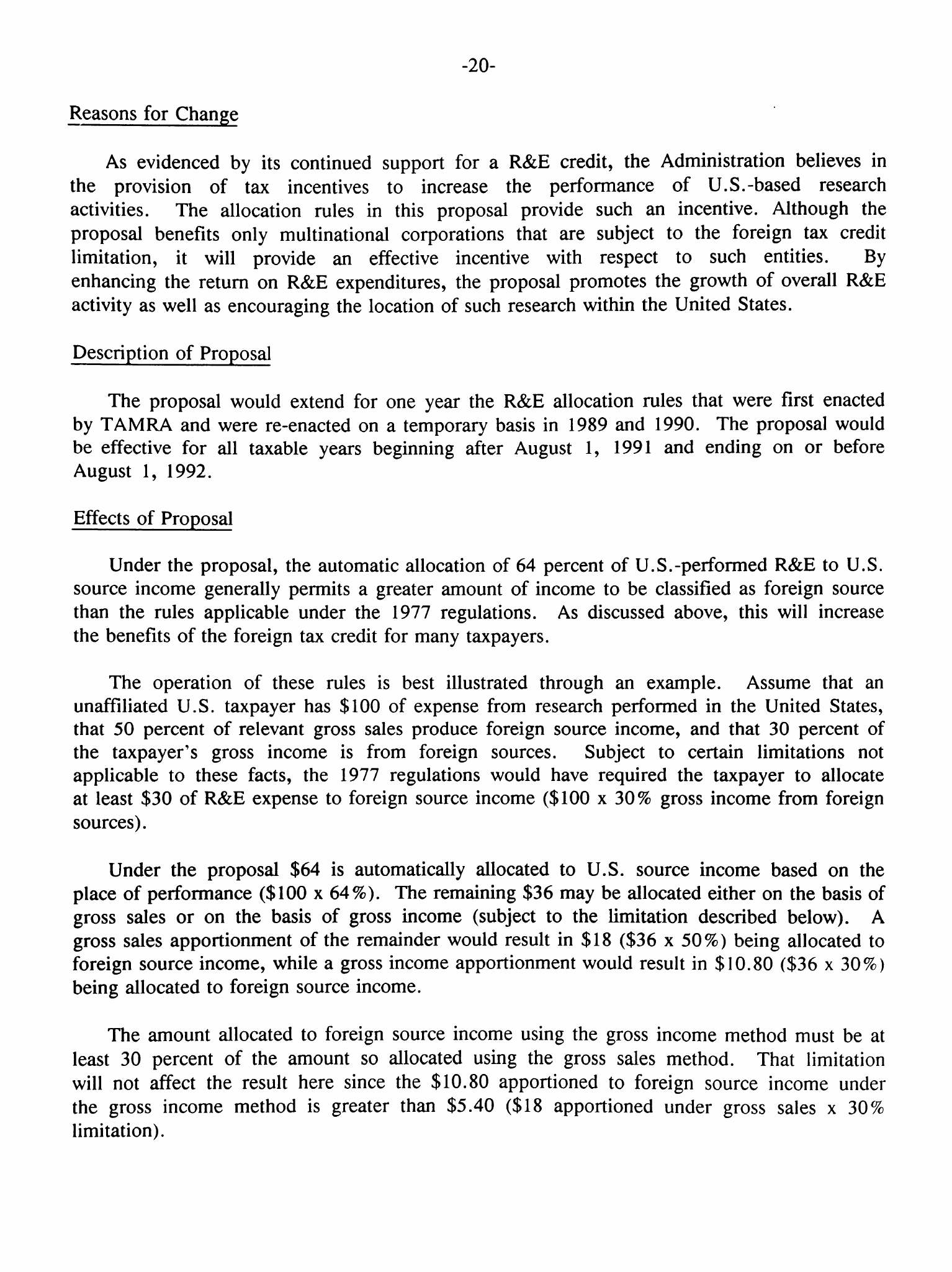
-20-
Reasons for Change
As evidenced by its continued support for a R&E credit, the Administration believes in
the provision of tax incentives to increase the performance of U.S.-based research
activities. The allocation rules in this proposal provide such an incentive. Although the
proposal benefits only multinational corporations that are subject to the foreign tax credit
limitation, it will provide an effective incentive with respect to such entities. By
enhancing the return on R&E expenditures, the proposal promotes the growth of overall R&E
activity as well as encouraging the location of such research within the United States.
Description of Proposal
The proposal would extend for one year the R&E allocation rules that were first enacted
by TAMRA and were re-enacted on a temporary basis in 1989 and 1990. The proposal would
be effective for all taxable years beginning after August 1, 1991 and ending on or before
August 1, 1992.
Effects of Proposal
Under the proposal, the automatic allocation of 64 percent of U.S.-performed R&E to U.S.
source income generally permits a greater amount of income to be classified as foreign source
than the rules applicable under the 1977 regulations. As discussed above, this will increase
the benefits of the foreign tax credit for many taxpayers.
The operation of these rules is best illustrated through an example. Assume that an
unaffiliated U.S. taxpayer has $100 of expense from research performed in the United States,
that 50 percent of relevant gross sales produce foreign source income, and that 30 percent of
the taxpayer's gross income is from foreign sources. Subject to certain limitations not
applicable to these facts, the 1977 regulations would have required the taxpayer to allocate
at least $30 of R&E expense to foreign source income ($100 x 30% gross income from foreign
sources).
Under the proposal $64 is automatically allocated to U.S. source income based on the
place of performance ($100 x
64%).
The remaining $36 may be allocated either on the basis of
gross sales or on the basis of gross income (subject to the limitation described
below).
A
gross sales apportionment of the remainder would result in $18 ($36 x 50%) being allocated to
foreign source income, while a gross income apportionment would result in $10.80 ($36 x 30%)
being allocated to foreign source income.
The amount allocated to foreign source income using the gross income method must be at
least 30 percent of the amount so allocated using the gross sales method. That limitation
will not affect the result here since the $10.80 apportioned to foreign source income under
the gross income method is greater than $5.40 ($18 apportioned under gross sales x 30%
limitation).
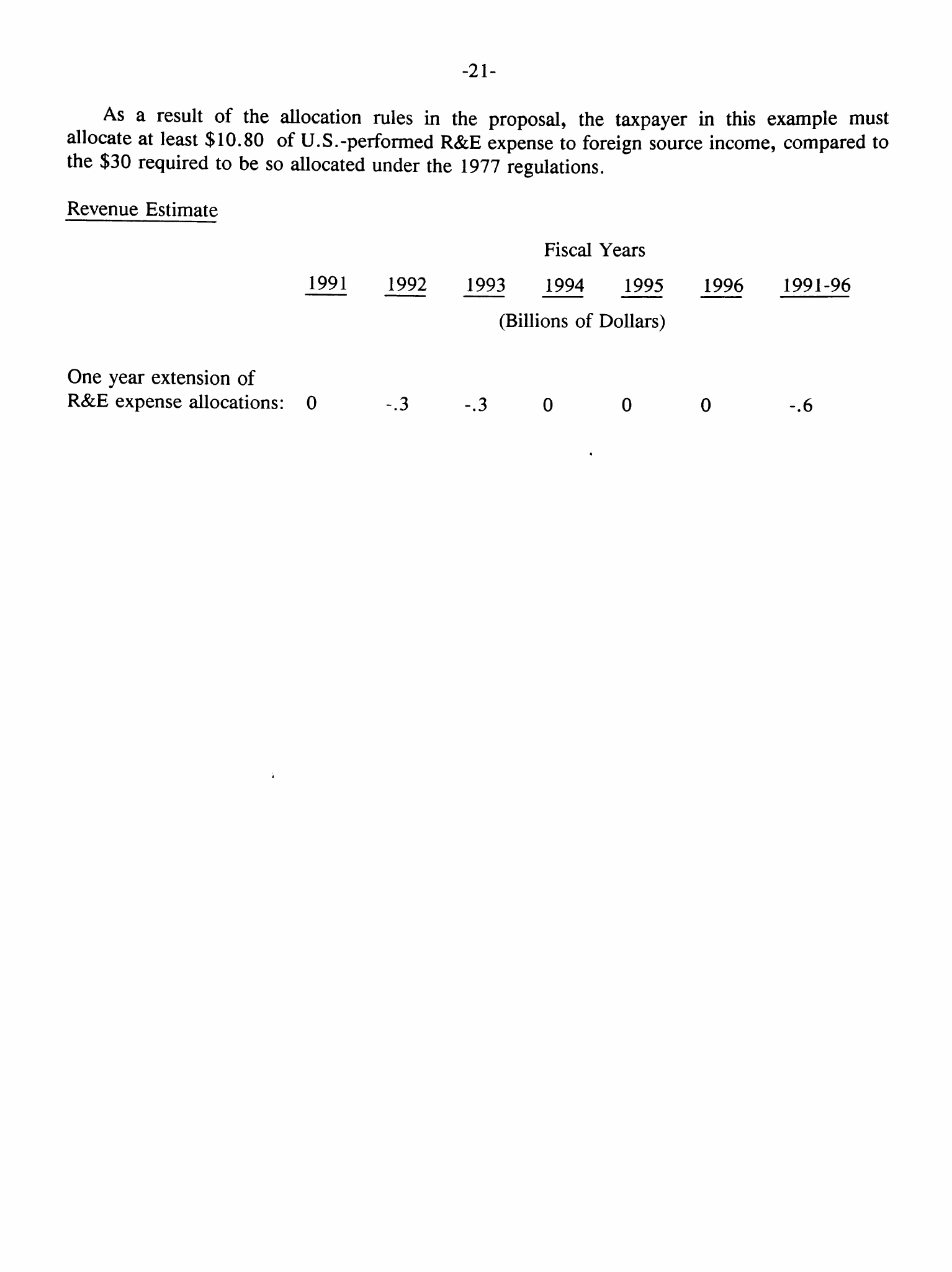
-21-
As a result of the allocation rules in the proposal, the taxpayer in this example must
allocate at least $10.80 of U.S.-performed R&E expense to foreign source income, compared to
the $30 required to be so allocated under the 1977 regulations.
Revenue Estimate
Fiscal Years
1991 1992 1993 1994 1995 1996 1991-96
(Billions of Dollars)
One year extension of
R&E expense allocations: 0 -.3 -.3 0 0 0 -.6

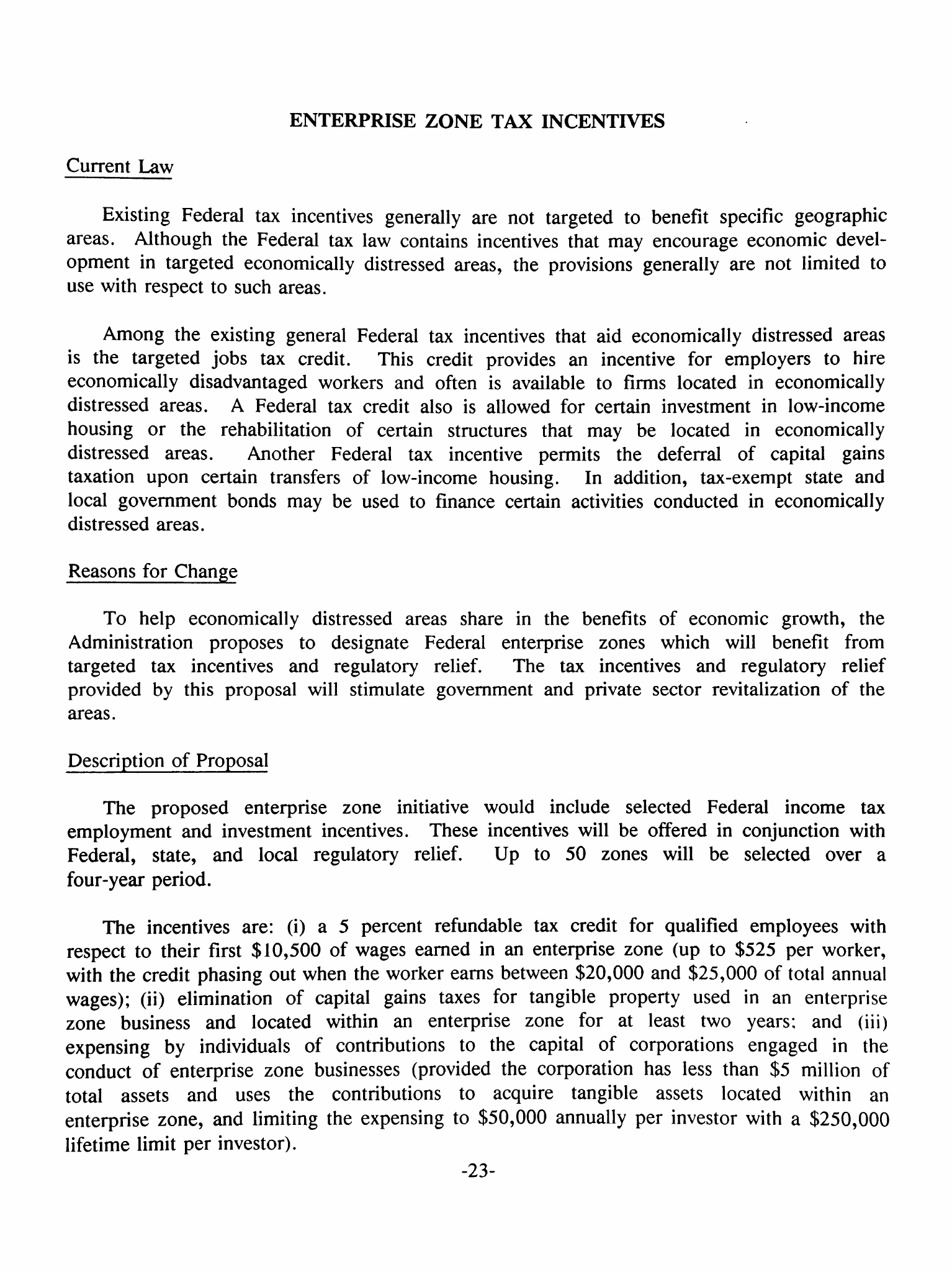
ENTERPRISE ZONE TAX INCENTIVES
Current Law
Existing Federal tax incentives generally are not targeted to benefit specific geographic
areas.
Although the Federal tax law contains incentives that may encourage economic devel-
opment in targeted economically distressed areas, the provisions generally are not limited to
use with respect to such areas.
Among the existing general Federal tax incentives that aid economically distressed areas
is the targeted jobs tax credit. This credit provides an incentive for employers to hire
economically disadvantaged workers and often is available to firms located in economically
distressed areas. A Federal tax credit also is allowed for certain investment in low-income
housing or the rehabilitation of certain structures that may be located in economically
distressed areas. Another Federal tax incentive permits the deferral of capital gains
taxation upon certain transfers of low-income housing. In addition, tax-exempt state and
local government bonds may be used to finance certain activities conducted in economically
distressed areas.
Reasons for Change
To help economically distressed areas share in the benefits of economic growth, the
Administration proposes to designate Federal enterprise zones which will benefit from
targeted tax incentives and regulatory relief. The tax incentives and regulatory relief
provided by this proposal will stimulate government and private sector revitalization of the
areas.
Description of Proposal
The proposed enterprise zone initiative would include selected Federal income tax
employment and investment incentives. These incentives will be offered in conjunction with
Federal, state, and local regulatory relief. Up to 50 zones will be selected over a
four-year period.
The incentives are: (i) a 5 percent refundable tax credit for qualified employees with
respect to their
first
$10,500 of wages earned in an enterprise zone (up to $525 per worker,
with the credit phasing out when the worker earns between $20,000 and $25,000 of total annual
wages);
(ii) elimination of capital gains taxes for tangible property used in an enterprise
zone business and located within an enterprise zone for at least two years; and (iii)
expensing by individuals of contributions to the capital of corporations engaged in the
conduct of enterprise zone businesses (provided the corporation has less than $5 million of
total assets and uses the contributions to acquire tangible assets located within an
enterprise zone, and limiting the expensing to $50,000 annually per investor with a $250,000
lifetime limit per
investor).
-23-
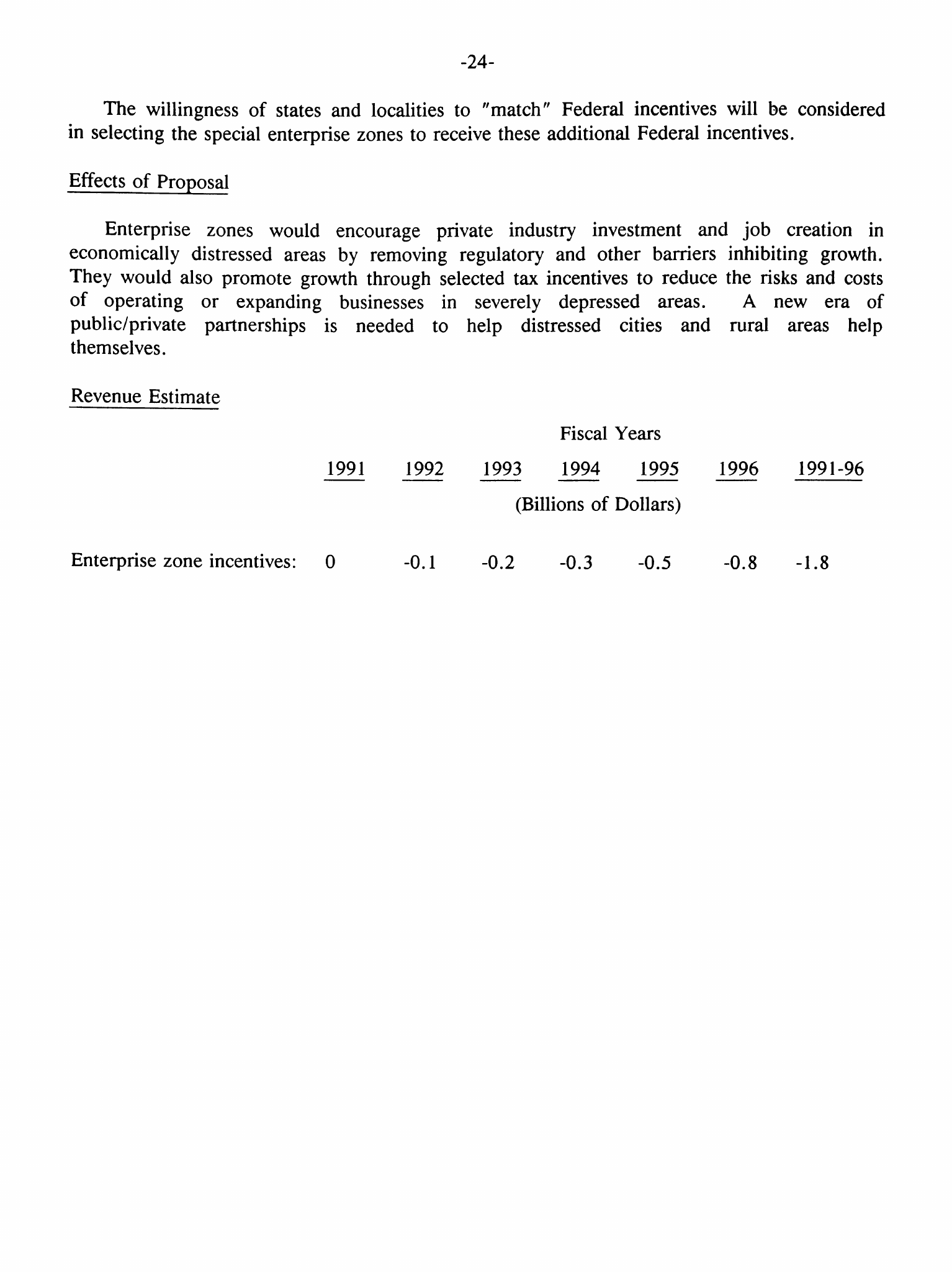
-24-
The willingness of states and localities to "match" Federal incentives will be considered
in selecting the special enterprise zones to receive these additional Federal incentives.
Effects of Proposal
Enterprise zones would encourage private industry investment and job creation in
economically distressed areas by removing regulatory and other barriers inhibiting growth.
They would also promote growth through selected tax incentives to reduce the risks and costs
of operating or expanding businesses in severely depressed areas. A new era of
public/private partnerships is needed to help distressed cities and rural areas help
themselves.
Revenue Estimate
Fiscal Years
1991 1992 1993 1994 1995 1996 1991-96
(Billions of Dollars)
Enterprise zone incentives: 0 -0.1 -0.2 -0.3 -0.5 -0.8 -1.8
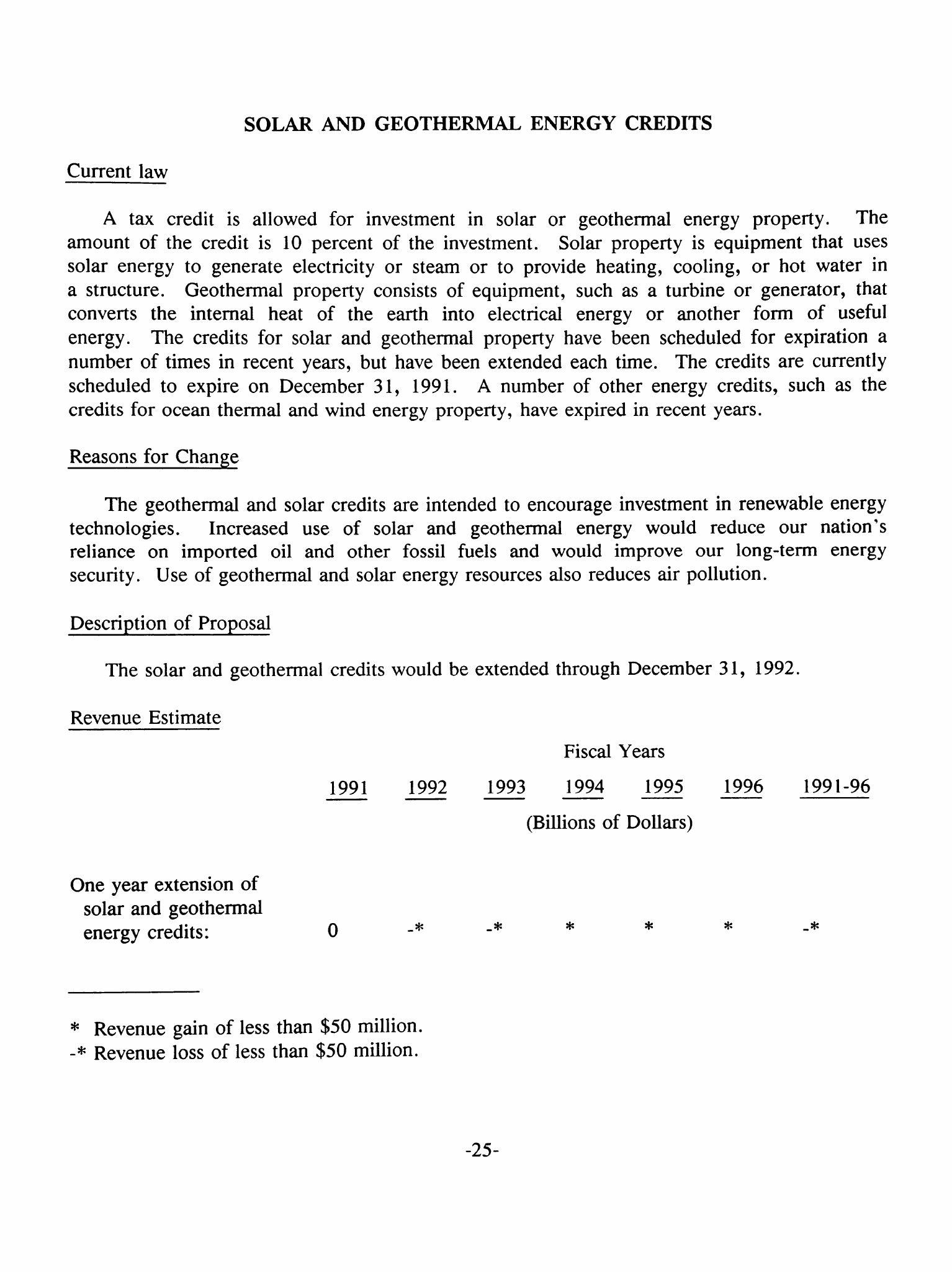
SOLAR AND GEOTHERMAL ENERGY CREDITS
Current law
A tax credit is allowed for investment in solar or geothermal energy property. The
amount of the credit is
10
percent of the investment. Solar property is equipment that uses
solar energy
to
generate electricity
or
steam
or to
provide heating, cooling,
or
hot water
in
a structure. Geothermal property consists of equipment, such as
a
turbine
or
generator, that
converts
the
internal heat
of the
earth into electrical energy
or
another form
of
useful
energy. The credits for solar and geothermal property have been scheduled for expiration
a
number of times in recent years, but have been extended each time. The credits are currently
scheduled
to
expire
on
December 31, 1991.
A
number of other energy credits, such
as the
credits for ocean thermal and wind energy property, have expired in recent years.
Reasons for Change
The geothermal and solar credits are intended to encourage investment in renewable energy
technologies. Increased
use of
solar
and
geothermal energy would reduce
our
nation's
reliance
on
imported
oil and
other fossil fuels
and
would improve
our
long-term energy
security. Use of geothermal and solar energy resources also reduces air pollution.
Description of Proposal
The solar and geothermal credits would be extended through December 31, 1992.
Revenue Estimate
Fiscal Years
1991
1992 1993 1994 1995 1996
1991-96
(Billions of Dollars)
One year extension of
solar and geothermal
energy
credits:
0 _*_**** _*
*
Revenue gain of less than $50 million.
-*
Revenue loss of less than $50 million.
-25-

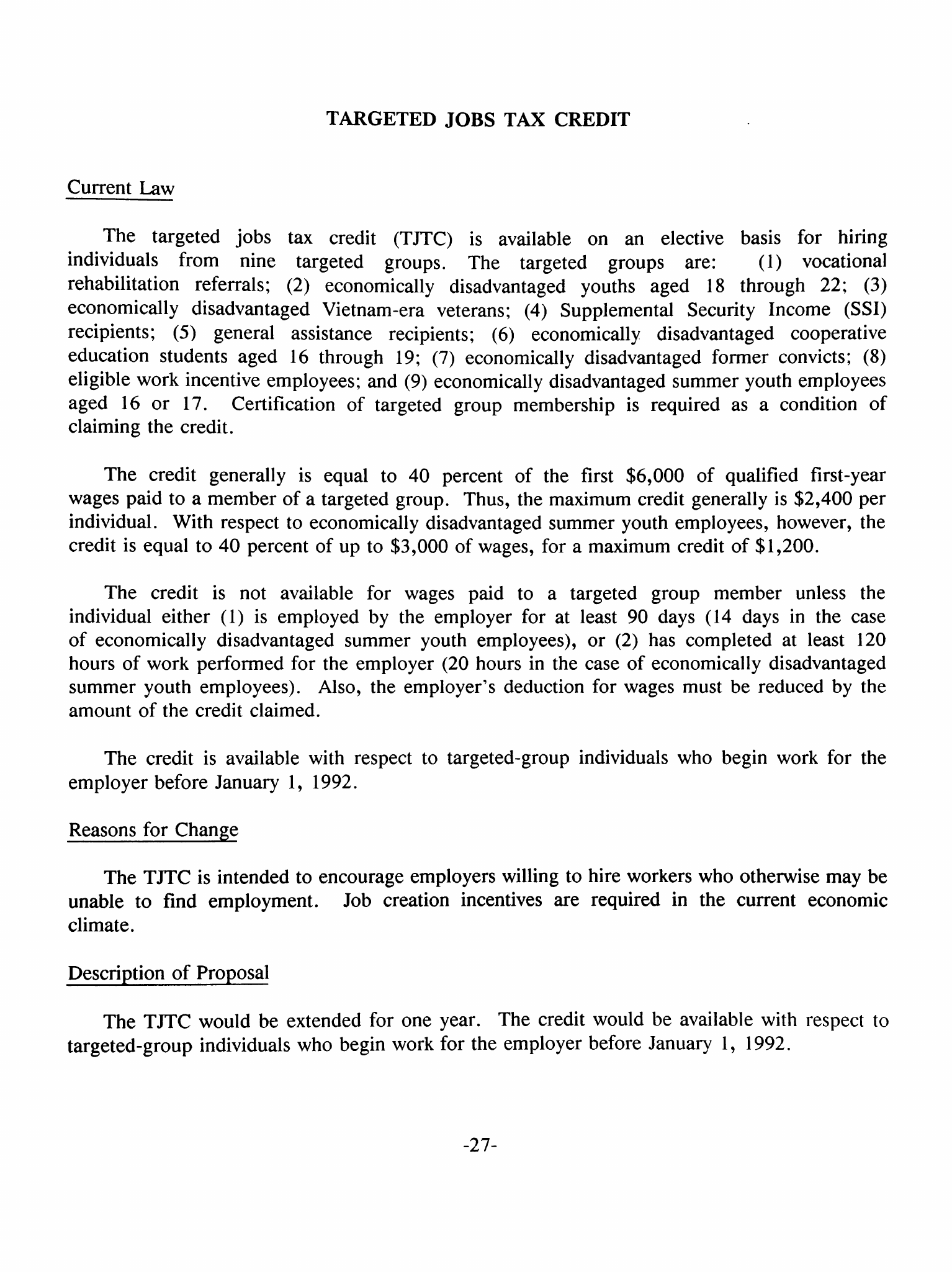
TARGETED JOBS TAX CREDIT
Current Law
The targeted jobs tax credit (TJTC) is available on an elective basis for hiring
individuals from nine targeted groups.
The
targeted groups
are: (1)
vocational
rehabilitation referrals;
(2)
economically disadvantaged youths aged
18
through 22;
(3)
economically disadvantaged Vietnam-era veterans; (4) Supplemental Security Income
(SSI)
recipients;
(5)
general assistance recipients;
(6)
economically disadvantaged cooperative
education students aged
16
through 19; (7) economically disadvantaged former convicts;
(8)
eligible work incentive employees; and
(9)
economically disadvantaged summer youth employees
aged
16 or
17. Certification
of
targeted group membership
is
required
as a
condition
of
claiming the credit.
The credit generally is equal to 40 percent of the first $6,000 of qualified first-year
wages paid to
a
member of a targeted group.
Thus,
the maximum credit generally is $2,400 per
individual.
With respect to economically disadvantaged summer youth employees, however, the
credit is equal to 40 percent of up to $3,000 of
wages,
for
a
maximum credit of
$1,200.
The credit is not available for wages paid to a targeted group member unless the
individual either (1) is employed
by
the employer for at least
90
days (14 days
in
the case
of economically disadvantaged summer youth
employees),
or
(2) has completed
at
least
120
hours of work performed for the employer (20 hours in the case of economically disadvantaged
summer youth
employees).
Also, the employer's deduction for wages must be reduced
by
the
amount of the credit claimed.
The credit is available with respect to targeted-group individuals who begin work for the
employer before January 1, 1992.
Reasons for Change
The TJTC is intended to encourage employers willing to hire workers who otherwise may be
unable
to
find employment.
Job
creation incentives
are
required
in the
current economic
climate.
Description of Proposal
The TJTC would be extended for one year. The credit would be available with respect to
targeted-group individuals who begin work for the employer before January 1, 1992.
-27-
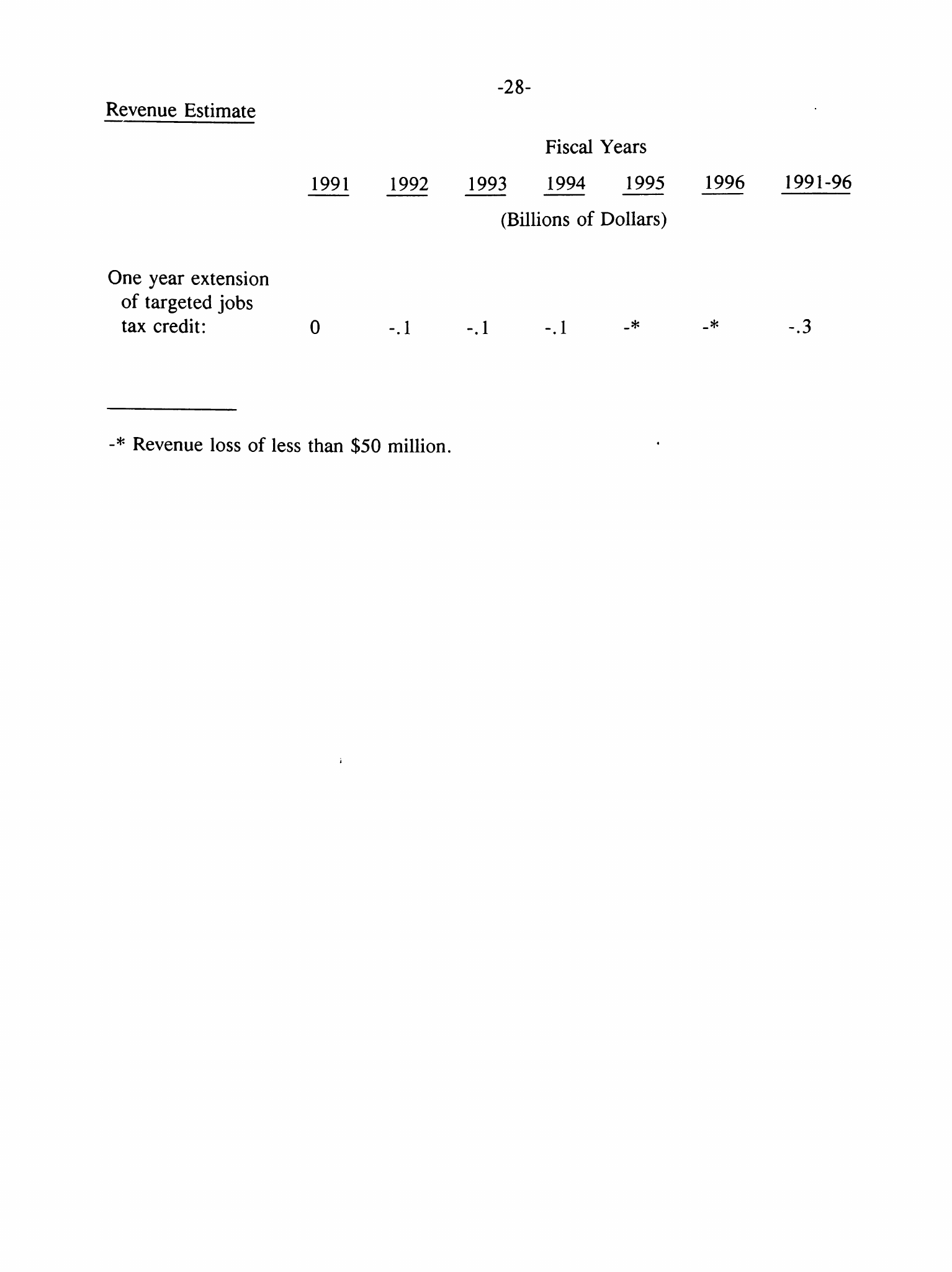
Revenue Estimate
-28-
Fiscal Years
1991 1992 1993 1994 1995 1996 1991-96
(Billions of Dollars)
One year extension
of targeted jobs
tax credit: 0 -.1 -.1 -.1 -* -* -.3
-* Revenue loss of less than $50 million.
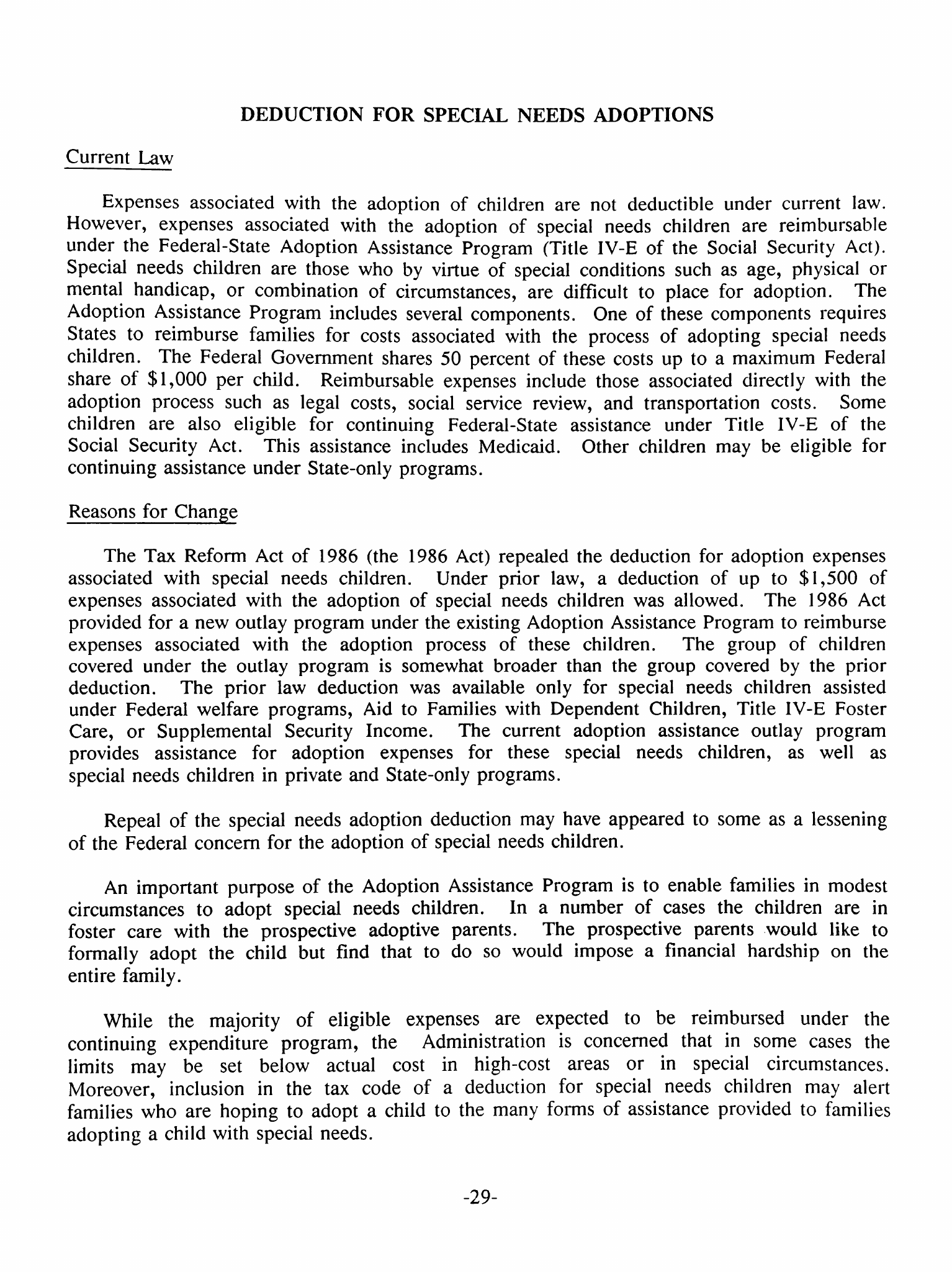
DEDUCTION FOR SPECIAL NEEDS ADOPTIONS
Current Law
Expenses associated with the adoption of children are not deductible under current law.
However, expenses associated with the adoption
of
special needs children are reimbursable
under the Federal-State Adoption Assistance Program (Title IV-E of the Social Security Act).
Special needs children are those who
by
virtue of special conditions such as age, physical
or
mental handicap,
or
combination
of
circumstances, are difficult
to
place for adoption.
The
Adoption Assistance Program includes several components. One of these components requires
States
to
reimburse families for costs associated with the process
of
adopting special needs
children. The Federal Government shares
50
percent of these costs
up
to
a
maximum Federal
share
of
$1,000 per child. Reimbursable expenses include those associated directly with
the
adoption process such
as
legal costs, social service review,
and
transportation costs. Some
children
are
also eligible
for
continuing Federal-State assistance under Title IV-E
of the
Social Security Act. This assistance includes Medicaid. Other children
may be
eligible for
continuing assistance under State-only programs.
Reasons for Change
The Tax Reform Act of 1986 (the 1986 Act) repealed the deduction for adoption expenses
associated with special needs children. Under prior law,
a
deduction
of up to
$1,500
of
expenses associated with the adoption of special needs children was allowed.
The
1986
Act
provided for
a
new outlay program under the existing Adoption Assistance Program to reimburse
expenses associated with
the
adoption process
of
these children.
The
group
of
children
covered under the outlay program is somewhat broader than the group covered
by
the prior
deduction.
The
prior
law
deduction
was
available only for special needs children assisted
under Federal welfare programs, Aid to Families with Dependent Children, Title IV-E Foster
Care,
or
Supplemental Security Income.
The
current adoption assistance outlay program
provides assistance
for
adoption expenses
for
these special needs children,
as
well
as
special needs children in private and State-only programs.
Repeal of the special needs adoption deduction may have appeared to some as a lessening
of the Federal concern for the adoption of special needs children.
An important purpose of the Adoption Assistance Program is to enable families in modest
circumstances
to
adopt special needs children.
In a
number
of
cases
the
children
are in
foster care with
the
prospective adoptive parents.
The
prospective parents would like
to
formally adopt the child but find that
to do so
would impose
a
financial hardship
on the
entire family.
While the majority of eligible expenses are expected to be reimbursed under the
continuing expenditure program,
the
Administration
is
concerned that
in
some cases
the
limits
may be set
below actual cost
in
high-cost areas
or in
special circumstances.
Moreover, inclusion
in the tax
code
of a
deduction
for
special needs children
may
alert
families who are hoping to adopt
a
child to the many forms of assistance provided to families
adopting
a
child with special needs.
-29-
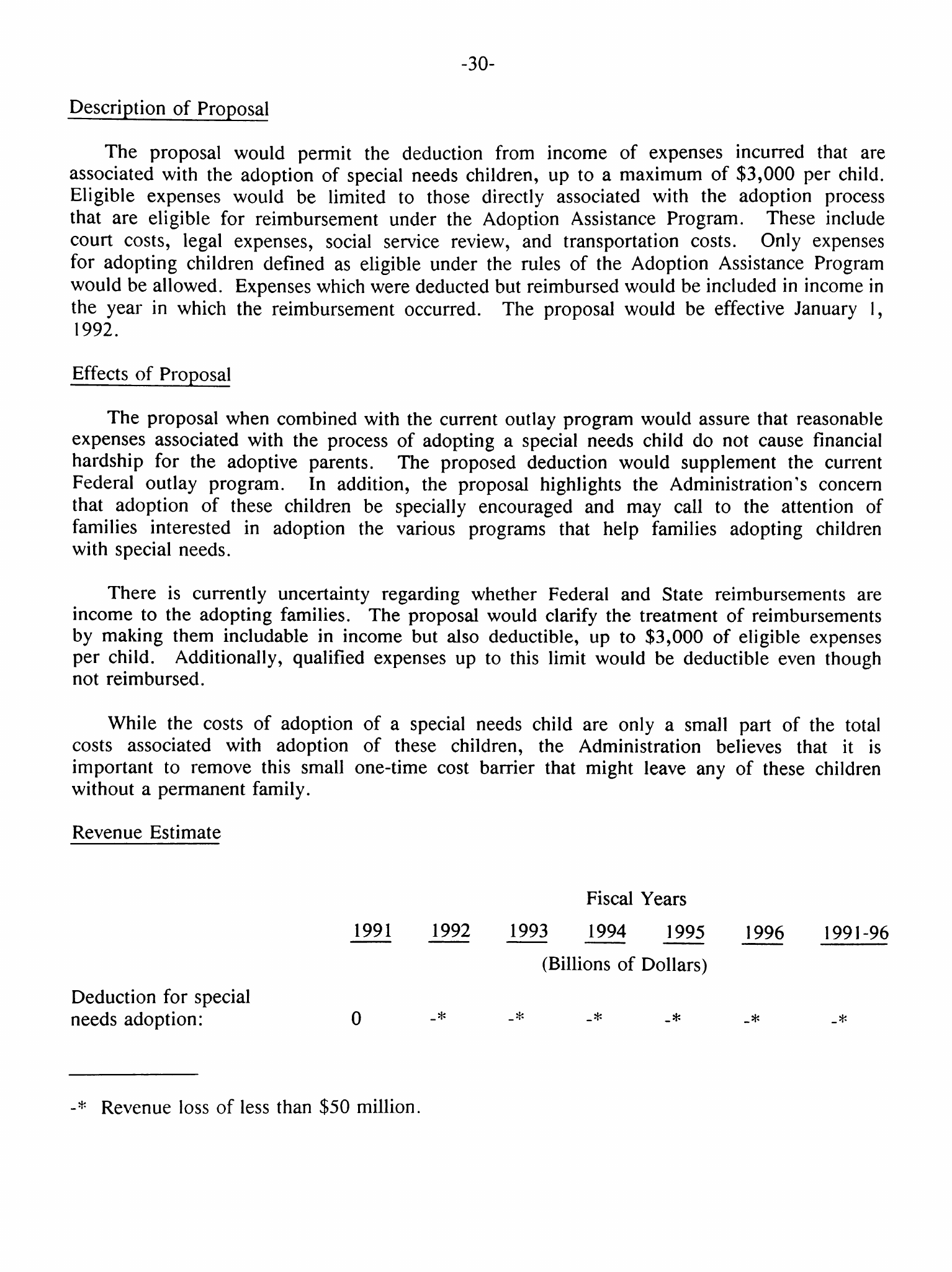
-30-
Description of Proposal
The proposal would permit the deduction from income of expenses incurred that are
associated with the adoption of special needs children, up to a maximum of $3,000 per child.
Eligible expenses would be limited to those directly associated with the adoption process
that are eligible for reimbursement under the Adoption Assistance Program. These include
court costs, legal expenses, social service review, and transportation costs. Only expenses
for adopting children defined as eligible under the rules of the Adoption Assistance Program
would be allowed. Expenses which were deducted but reimbursed would be included in income in
the year in which the reimbursement occurred. The proposal would be effective January 1,
1992.
Effects of Proposal
The proposal when combined with the current outlay program would assure that reasonable
expenses associated with the process of adopting a special needs child do not cause financial
hardship for the adoptive parents. The proposed deduction would supplement the current
Federal outlay program. In addition, the proposal highlights the Administration's concern
that adoption of these children be specially encouraged and may call to the attention of
families interested in adoption the various programs that help families adopting children
with special needs.
There is currently uncertainty regarding whether Federal and State reimbursements are
income to the adopting families. The proposal would clarify the treatment of reimbursements
by making them includable in income but also deductible, up to $3,000 of eligible expenses
per child. Additionally, qualified expenses up to this limit would be deductible even though
not reimbursed.
While the costs of adoption of a special needs child are only a small part of the total
costs associated with adoption of these children, the Administration believes that it is
important to remove this small one-time cost barrier that might leave any of these children
without a permanent family.
Revenue Estimate
Fiscal Years
1991 1992 1993 1994 1995 1996 1991-96
(Billions of Dollars)
Deduction for special
needs adoption: 0 -* -* -* -* -* .*
-* Revenue loss of less than $50 million.
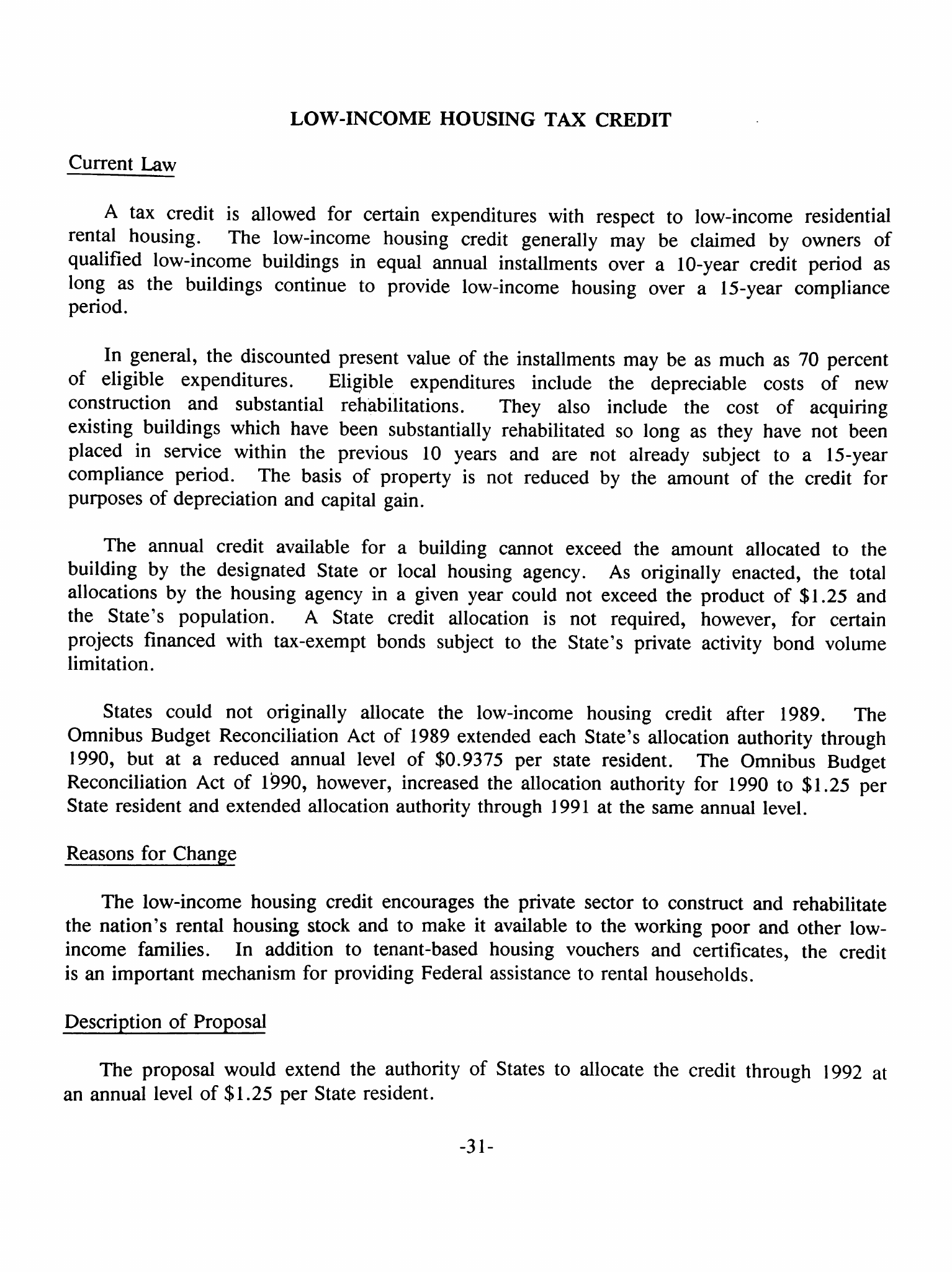
LOW-INCOME HOUSING TAX CREDIT
Current Law
A tax credit is allowed for certain expenditures with respect to low-income residential
rental housing.
The
low-income housing credit generally
may be
claimed
by
owners
of
qualified low-income buildings
in
equal annual installments over
a
10-year credit period
as
long
as the
buildings continue
to
provide low-income housing over
a
15-year compliance
period.
In general, the discounted present value of the installments may be as much as 70 percent
of eligible expenditures. Eligible expenditures include
the
depreciable costs
of new
construction
and
substantial rehabilitations. They also include
the
cost
of
acquiring
existing buildings which have been substantially rehabilitated
so
long
as
they have not been
placed
in
service within
the
previous
10
years
and are not
already subject
to a
15-year
compliance period. The basis
of
property
is
not reduced
by
the amount
of
the credit for
purposes of depreciation and capital gain.
The annual credit available for a building cannot exceed the amount allocated to the
building
by
the designated State
or
local housing agency.
As
originally enacted, the total
allocations
by
the housing agency in
a
given year could not exceed the product of $1.25 and
the State's population.
A
State credit allocation
is not
required, however,
for
certain
projects financed with tax-exempt bonds subject
to
the State's private activity bond volume
limitation.
States could not originally allocate the low-income housing credit after 1989. The
Omnibus Budget Reconciliation Act of 1989 extended each State's allocation authority through
1990,
but at a
reduced annual level
of
$0.9375 per state resident.
The
Omnibus Budget
Reconciliation Act
of
1990, however, increased the allocation authority for 1990 to $1.25 per
State resident and extended allocation authority through 1991 at the same annual level.
Reasons for Change
The low-income housing credit encourages the private sector to construct and rehabilitate
the nation's rental housing stock and to make it available to the working poor and other low-
income families.
In
addition
to
tenant-based housing vouchers
and
certificates,
the
credit
is an important mechanism for providing Federal assistance to rental households.
Description of Proposal
The proposal would extend the authority of States to allocate the credit through 1992 at
an annual level of $1.25 per State resident.
-31-
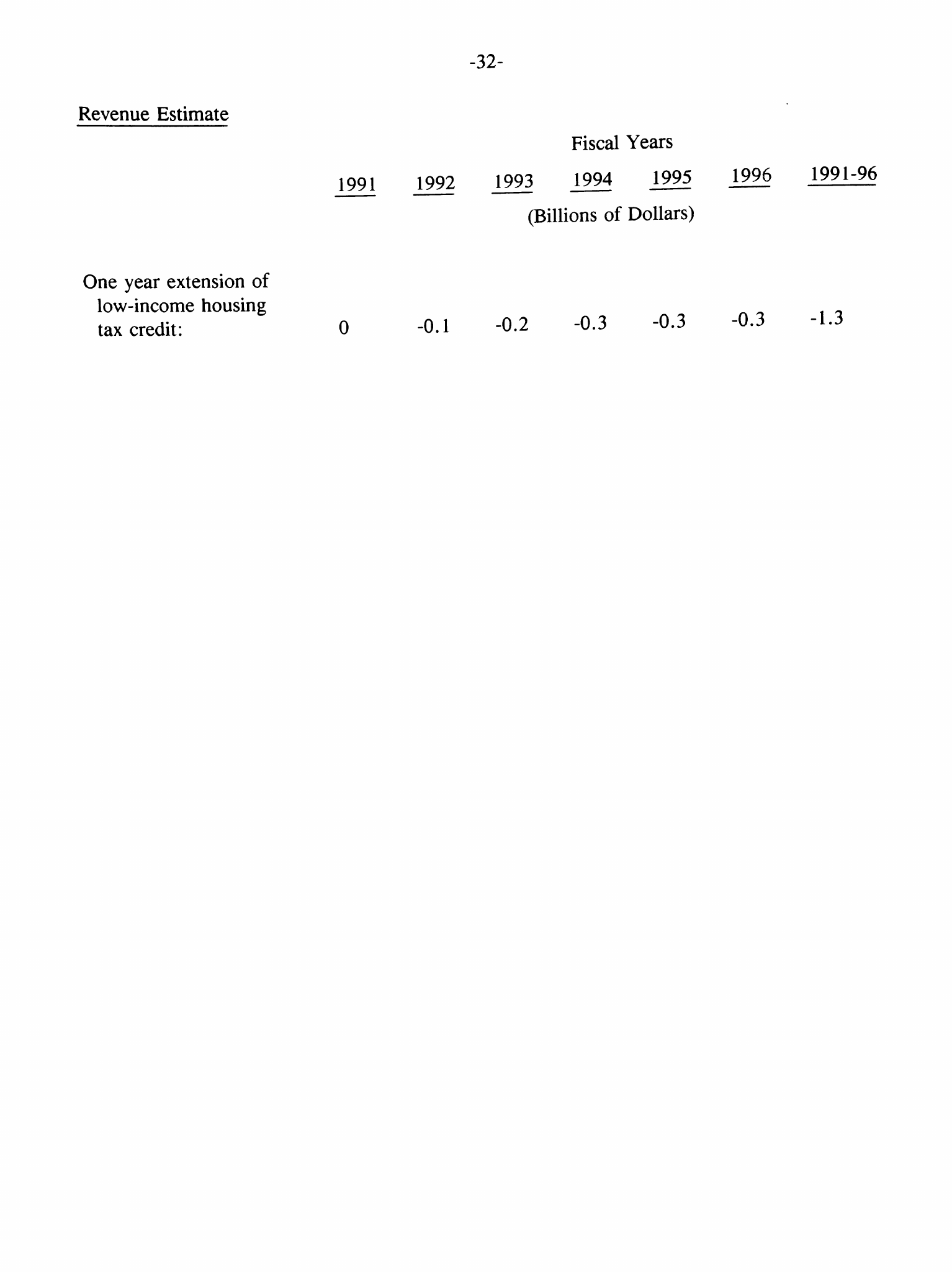
-32-
Revenue Estimate
Fiscal Years
1991 1992 1993 1994 1995
(Billions of Dollars)
One year extension of
low-income housing
tax credit:
0 -0.1
-0.2 -0.3 -0.3
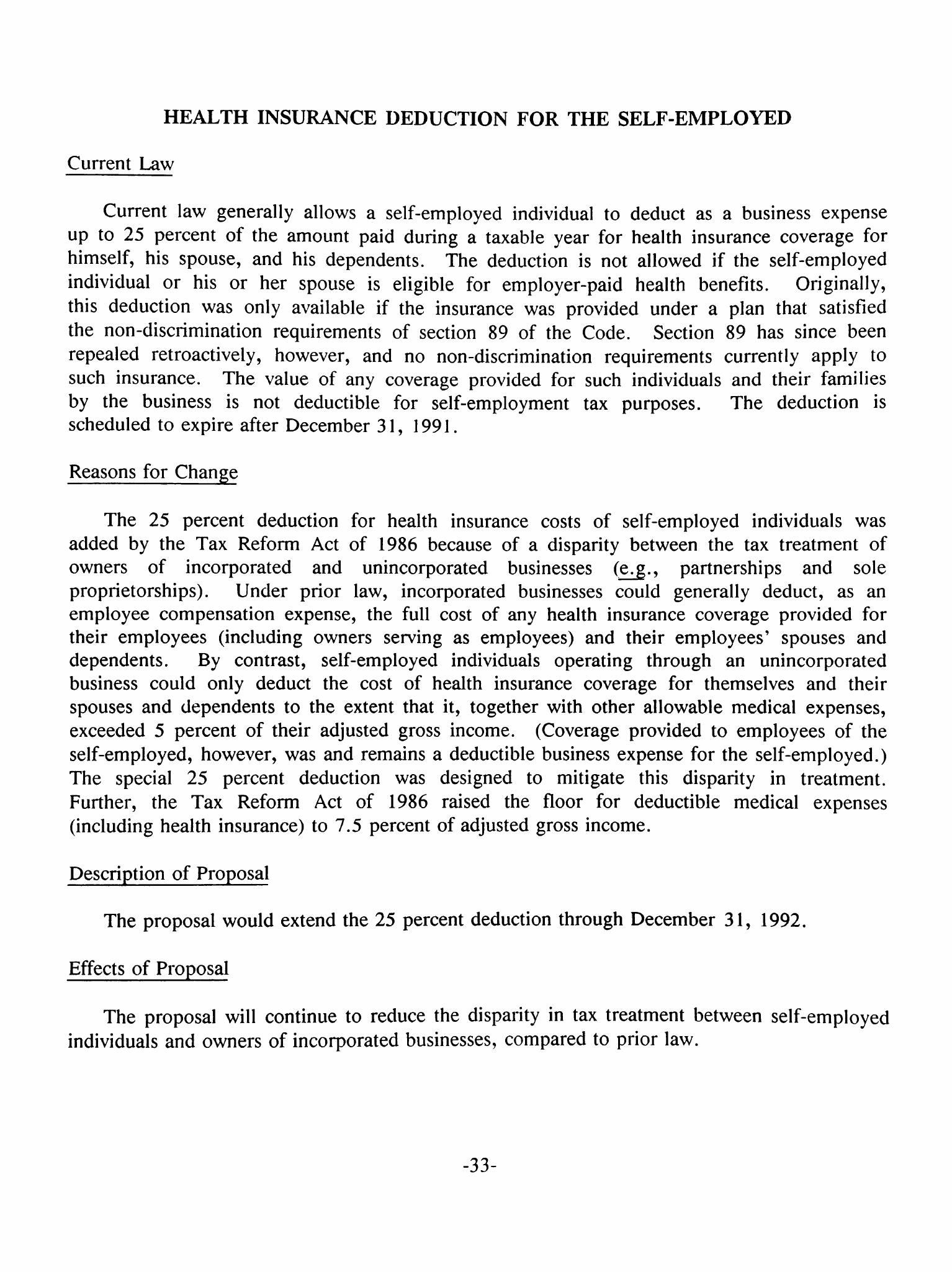
HEALTH INSURANCE DEDUCTION FOR THE SELF-EMPLOYED
Current Law
Current law generally allows a self-employed individual to deduct as a business expense
up
to 25
percent of the amount paid during
a
taxable year for health insurance coverage for
himself, his spouse, and his dependents. The deduction is not allowed if the self-employed
individual
or
his
or her
spouse
is
eligible
for
employer-paid health benefits. Originally,
this deduction was only available if the insurance was provided under
a
plan that satisfied
the non-discrimination requirements
of
section
89 of
the Code. Section
89
has since been
repealed retroactively, however,
and no
non-discrimination requirements currently apply
to
such insurance. The value
of
any coverage provided for such individuals
and
their families
by
the
business
is not
deductible
for
self-employment
tax
purposes.
The
deduction
is
scheduled to expire after December
31,
1991.
Reasons for Change
The 25 percent deduction for health insurance costs of self-employed individuals was
added
by
the
Tax
Reform Act
of
1986 because
of a
disparity between the tax treatment
of
owners
of
incorporated
and
unincorporated businesses (e.g., partnerships
and
sole
proprietorships).
Under prior law, incorporated businesses could generally deduct,
as an
employee compensation expense, the full cost of any health insurance coverage provided for
their employees (including owners serving
as
employees)
and
their employees' spouses
and
dependents.
By
contrast, self-employed individuals operating through
an
unincorporated
business could only deduct
the
cost
of
health insurance coverage for themselves
and
their
spouses and dependents to the extent that
it,
together with other allowable medical expenses,
exceeded
5
percent of their adjusted gross income. (Coverage provided
to
employees of the
self-employed, however, was and remains
a
deductible business expense for the self-employed.)
The special
25
percent deduction
was
designed
to
mitigate this disparity
in
treatment.
Further,
the Tax
Reform
Act of
1986 raised
the
floor
for
deductible medical expenses
(including health insurance) to 7.5 percent of adjusted gross income.
Description of Proposal
The proposal would extend the 25 percent deduction through December 31, 1992.
Effects of Proposal
The proposal will continue to reduce the disparity in tax treatment between self-employed
individuals and owners of incorporated businesses, compared to prior law.
-33-
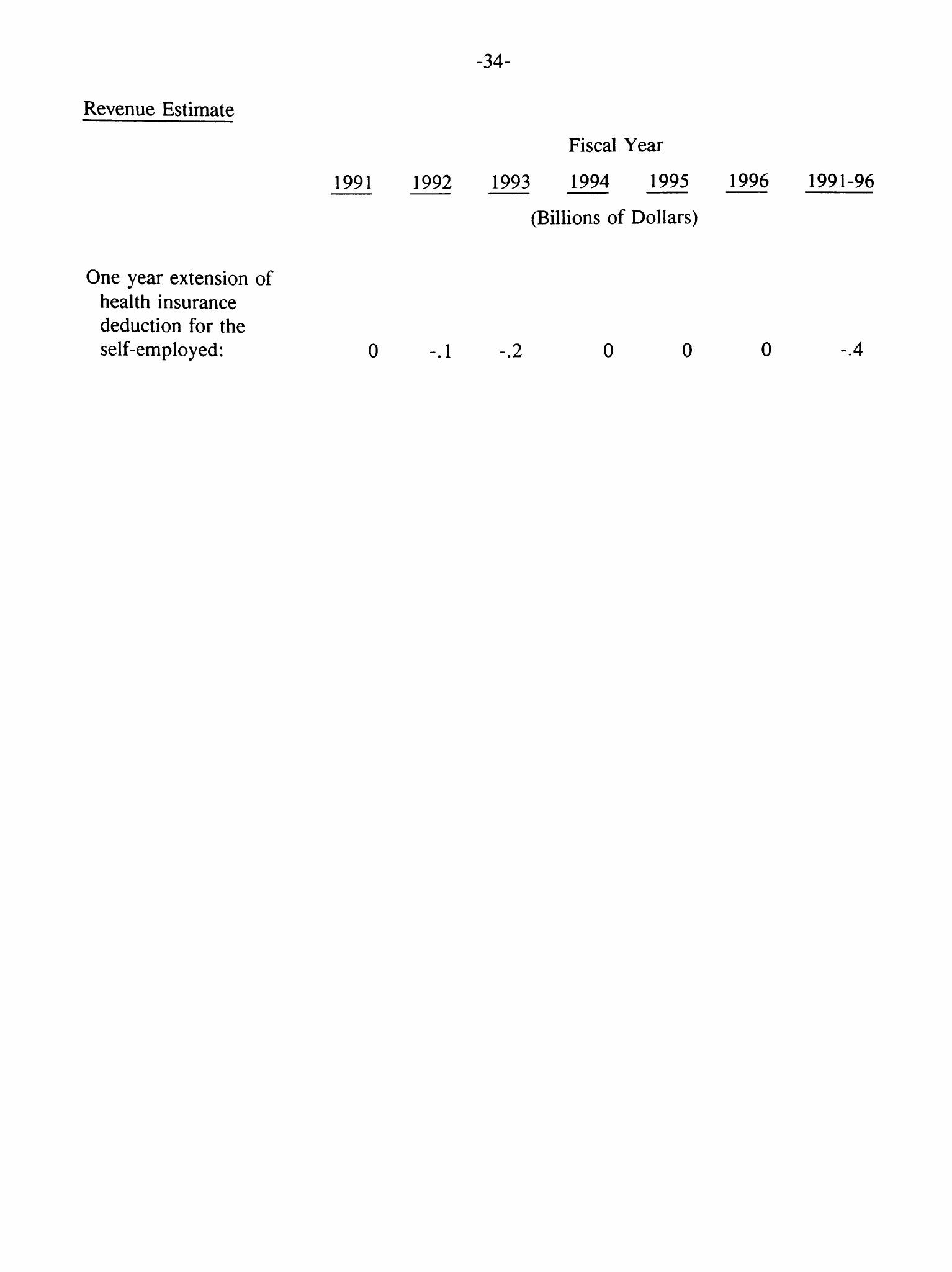
-34-
Revenue Estimate
Fiscal Year
1991 1992 1993 1994 1995 1996 1991-96
(Billions of Dollars)
One year extension of
health insurance
deduction for the
self-employed: 0 -.1 -.2 0 0 0 -.4
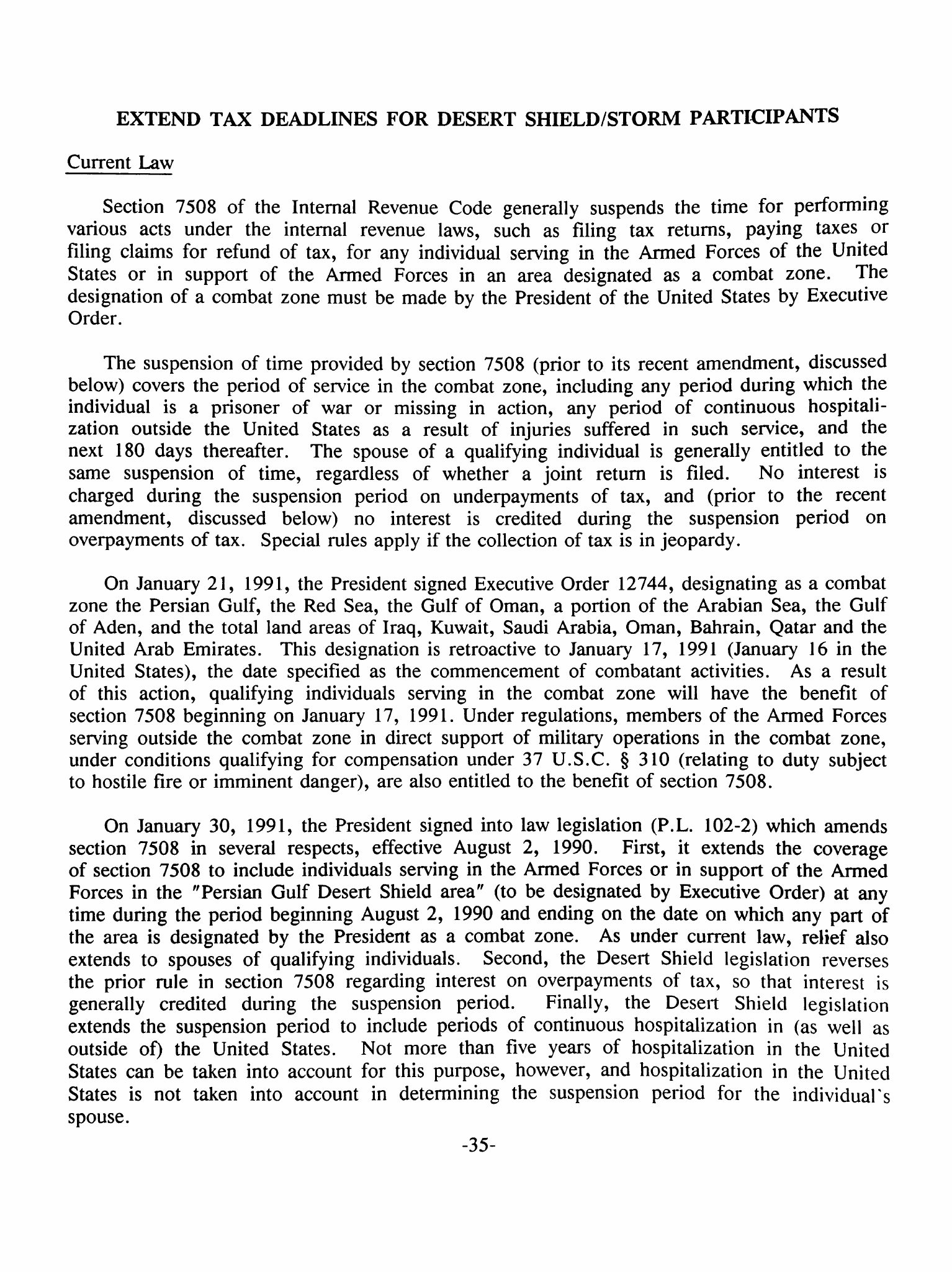
EXTEND TAX DEADLINES FOR DESERT SHIELD/STORM PARTICIPANTS
Current Law
Section 7508 of the Internal Revenue Code generally suspends the time for performing
various acts under
the
internal revenue
laws,
such
as
filing
tax
returns, paying taxes
or
filing claims for refund of tax, for any individual serving
in
the Armed Forces of the United
States
or in
support
of
the Armed Forces
in an
area designated
as a
combat zone.
The
designation of
a
combat zone must be made by the President of the United States
by
Executive
Order.
The suspension of time provided by section 7508 (prior to its recent amendment, discussed
below) covers the period of service in the combat zone, including any period during which the
individual
is a
prisoner
of war or
missing
in
action,
any
period
of
continuous hospitali-
zation outside
the
United States
as a
result
of
injuries suffered
in
such service,
and the
next 180 days thereafter.
The
spouse of
a
qualifying individual is generally entitled
to the
same suspension
of
time, regardless
of
whether
a
joint return
is
filed.
No
interest
is
charged during
the
suspension period
on
underpayments
of
tax,
and
(prior
to the
recent
amendment, discussed below)
no
interest
is
credited during
the
suspension period
on
overpayments of
tax.
Special rules apply
if
the collection of tax is in jeopardy.
On January 21, 1991, the President signed Executive Order 12744, designating as a combat
zone the Persian Gulf, the Red Sea, the Gulf of Oman,
a
portion of the Arabian Sea, the Gulf
of Aden, and the total land areas of
Iraq,
Kuwait, Saudi Arabia, Oman, Bahrain, Qatar and the
United Arab Emirates. This designation is retroactive to January 17, 1991 (January 16 in the
United
States),
the date specified as the commencement of combatant activities.
As a
result
of this action, qualifying individuals serving
in the
combat zone will have
the
benefit
of
section 7508 beginning on January 17, 1991. Under
regulations,
members of the Armed Forces
serving outside the combat zone in direct support of military operations
in
the combat zone,
under conditions qualifying for compensation under 37 U.S.C.
§
310 (relating to duty subject
to hostile
fire
or imminent
danger),
are also entitled to the benefit of section
7508.
On January 30, 1991, the President signed into law legislation (P.L. 102-2) which amends
section 7508
in
several respects, effective August 2, 1990. First,
it
extends the coverage
of section 7508 to include individuals serving in the Armed Forces or in support of the Armed
Forces in the "Persian Gulf Desert Shield area" (to
be
designated
by
Executive Order) at any
time during the period beginning August 2, 1990 and ending on the date on which any part
of
the area is designated
by
the President as
a
combat zone.
As
under current law, relief also
extends
to
spouses
of
qualifying individuals. Second, the Desert Shield legislation reverses
the prior rule
in
section 7508 regarding interest
on
overpayments
of
tax,
so
that interest
is
generally credited during
the
suspension period. Finally,
the
Desert Shield legislation
extends the suspension period
to
include periods of continuous hospitalization
in
(as well
as
outside of)
the
United States.
Not
more than five years
of
hospitalization
in the
United
States can
be
taken into account for this purpose, however, and hospitalization
in
the United
States
is not
taken into account
in
determining
the
suspension period
for the
individual's
spouse.
-35-
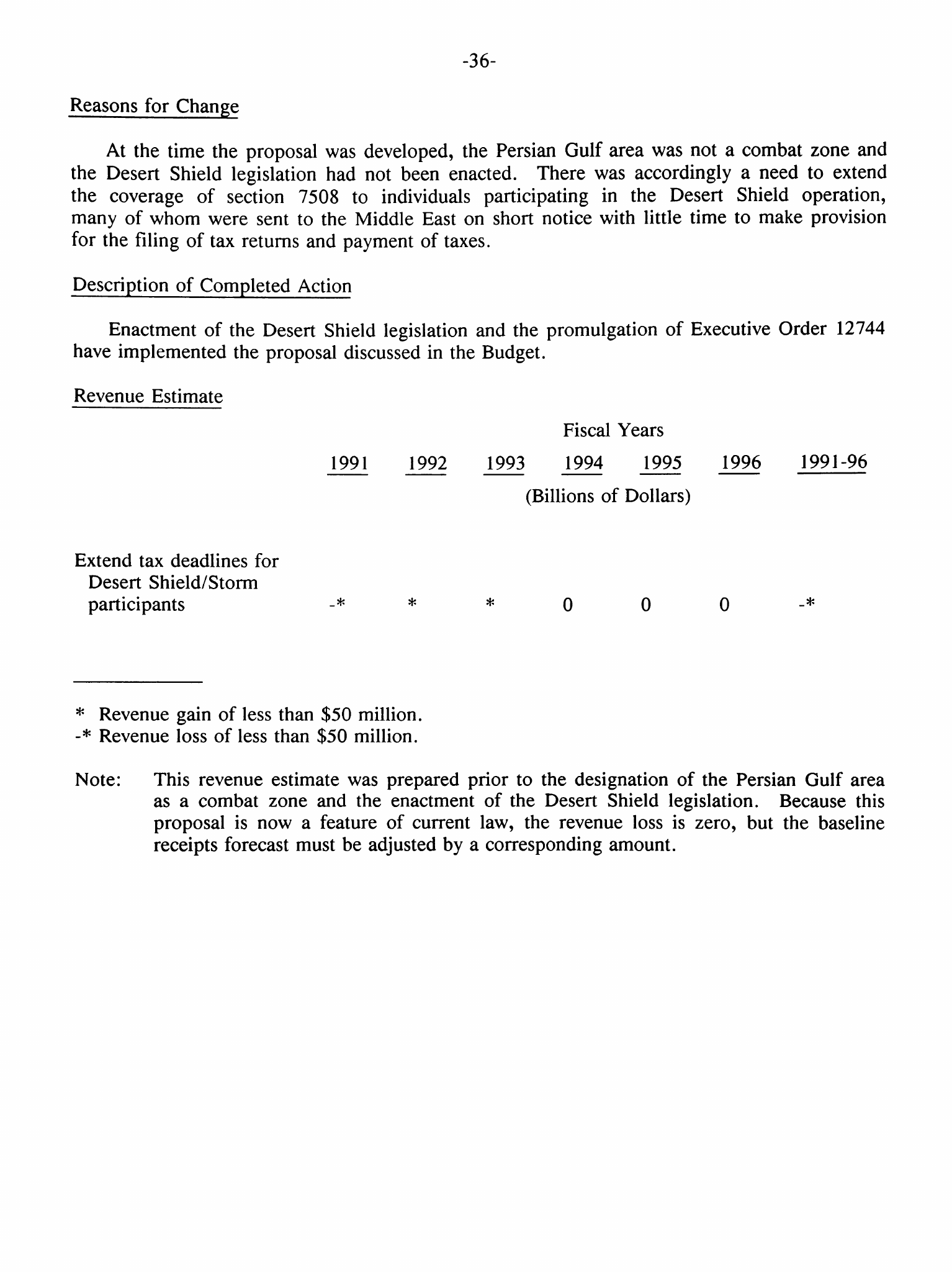
-36-
Reasons for Change
At the time the proposal was developed, the Persian Gulf area was not a combat zone and
the Desert Shield legislation had not been enacted. There was accordingly a need to extend
the coverage of section 7508 to individuals participating in the Desert Shield operation,
many of whom were sent to the Middle East on short notice with little time to make provision
for the filing of tax returns and payment of taxes.
Description of Completed Action
Enactment of the Desert Shield legislation and the promulgation of Executive Order 12744
have implemented the proposal discussed in the Budget.
Revenue Estimate
Fiscal Years
1991 1992 1993 1994 1995 1996 1991-96
(Billions of Dollars)
Extend tax deadlines for
Desert Shield/Storm
participants -* * * 0 0 0 -*
* Revenue gain of less than $50 million.
-* Revenue loss of less than $50 million.
Note: This revenue estimate was prepared prior to the designation of the Persian Gulf area
as a combat zone and the enactment of the Desert Shield legislation. Because this
proposal is now a feature of current law, the revenue loss is zero, but the baseline
receipts forecast must be adjusted by a corresponding amount.
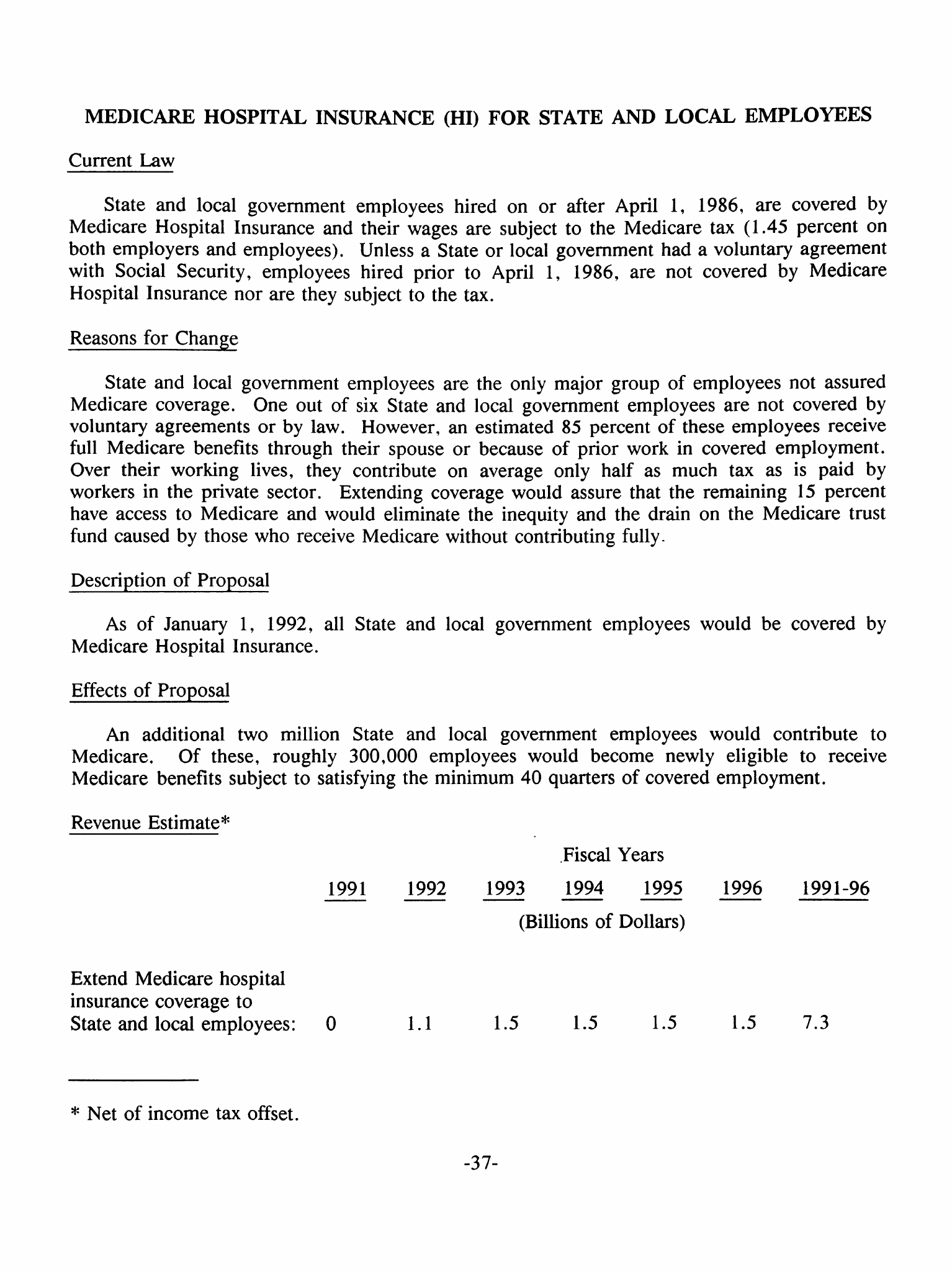
MEDICARE HOSPITAL INSURANCE
(HI)
FOR STATE AND LOCAL EMPLOYEES
Current Law
State and local government employees hired on or after April 1, 1986, are covered by
Medicare Hospital Insurance and their wages are subject to the Medicare tax (1.45 percent
on
both employers and
employees).
Unless
a
State or local government had
a
voluntary agreement
with Social Security, employees hired prior
to
April
1,
1986, are not covered
by
Medicare
Hospital Insurance nor are they subject to the tax.
Reasons for Change
State and local government employees are the only major group of employees not assured
Medicare coverage. One out of six State and local government employees are not covered
by
voluntary agreements or by law. However, an estimated 85 percent of these employees receive
full Medicare benefits through their spouse or because of prior work in covered employment.
Over their working lives, they contribute
on
average only half
as
much
tax as is
paid
by
workers in the private sector. Extending coverage would assure that the remaining
15
percent
have access to Medicare and would eliminate the inequity and the drain
on
the Medicare trust
fund caused by those who receive Medicare without contributing fully.
Description of Proposal
As of January 1, 1992, all State and local government employees would be covered by
Medicare Hospital Insurance.
Effects of Proposal
An additional two million State and local government employees would contribute to
Medicare.
Of
these, roughly 300,000 employees would become newly eligible
to
receive
Medicare benefits subject to satisfying the minimum 40 quarters of covered employment.
Revenue Estimate*
Fiscal Years
1991 1992 1993 1994 1995 1996 1991-96
(Billions of Dollars)
Extend Medicare hospital
insurance coverage to
State and local employees:
0 1.1 1.5 1.5 1.5 1.5 7.3
*
Net of income tax offset.
-37-

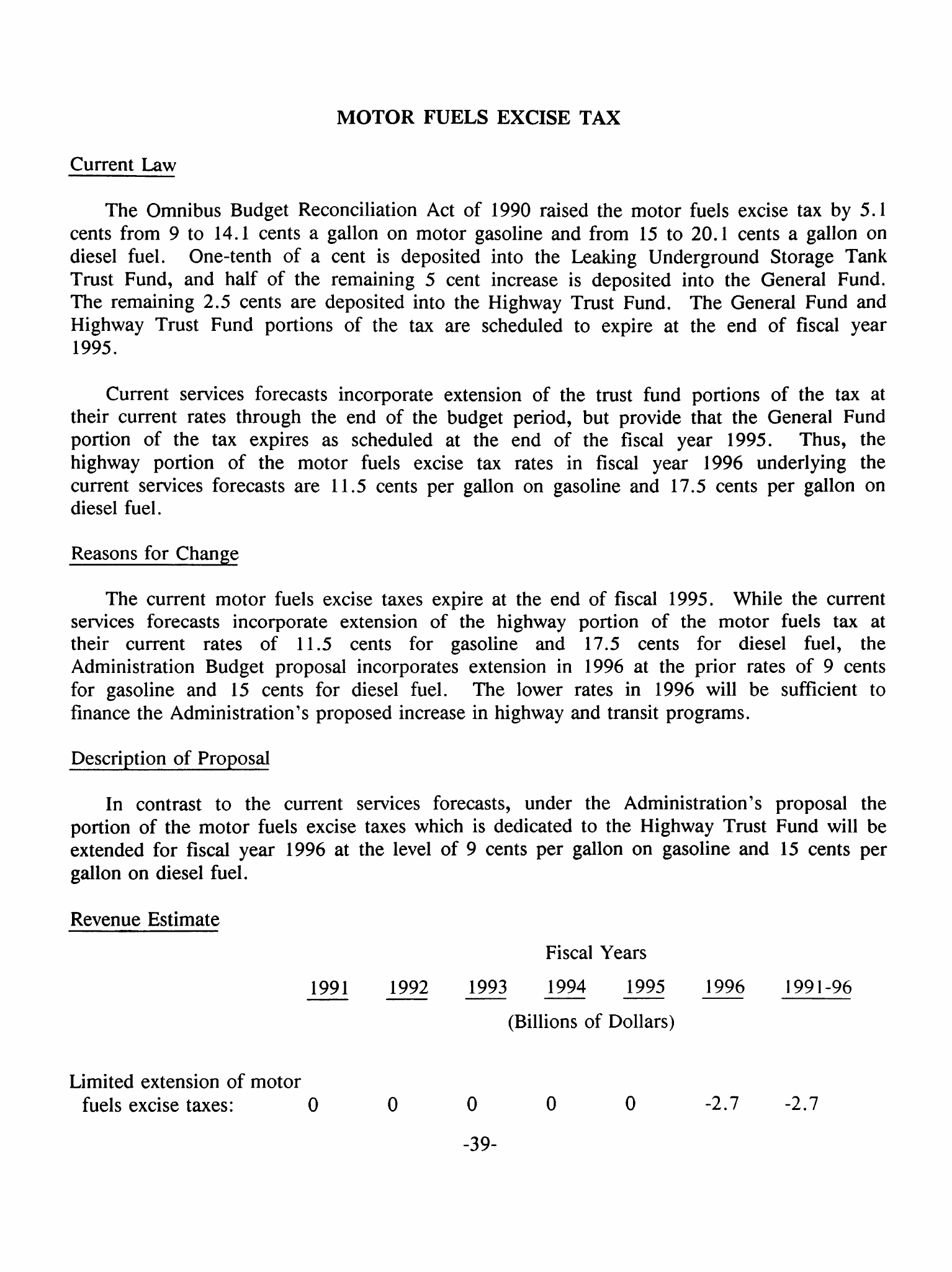
MOTOR FUELS EXCISE TAX
Current Law
The Omnibus Budget Reconciliation Act of 1990 raised the motor fuels excise tax by 5.1
cents from 9 to 14.1 cents a gallon on motor gasoline and from 15 to 20.1 cents a gallon on
diesel fuel. One-tenth of a cent is deposited into the Leaking Underground Storage Tank
Trust Fund, and half of the remaining 5 cent increase is deposited into the General Fund.
The remaining 2.5 cents are deposited into the Highway Trust Fund. The General Fund and
Highway Trust Fund portions of the tax are scheduled to expire at the end of fiscal year
1995.
Current services forecasts incorporate extension of the trust fund portions of the tax at
their current rates through the end of the budget period, but provide that the General Fund
portion of the tax expires as scheduled at the end of the fiscal year 1995.
Thus,
the
highway portion of the motor fuels excise tax rates in fiscal year 1996 underlying the
current services forecasts are 11.5 cents per gallon on gasoline and 17.5 cents per gallon on
diesel fuel.
Reasons for Change
The current motor fuels excise taxes expire at the end of fiscal 1995. While the current
services forecasts incorporate extension of the highway portion of the motor fuels tax at
their current rates of 11.5 cents for gasoline and 17.5 cents for diesel fuel, the
Administration Budget proposal incorporates extension in 1996 at the prior rates of 9 cents
for gasoline and 15 cents for diesel fuel. The lower rates in 1996 will be sufficient to
finance the Administration's proposed increase in highway and transit programs.
Description of Proposal
In contrast to the current services forecasts, under the Administration's proposal the
portion of the motor fuels excise taxes which is dedicated to the Highway Trust Fund will be
extended for fiscal year 1996 at the level of 9 cents per gallon on gasoline and 15 cents per
gallon on diesel fuel.
Revenue Estimate
Fiscal Years
1991 1992 1993 1994 1995 1996 1991-96
(Billions of Dollars)
Limited extension of motor
fuels excise
taxes:
0 0 0 0 0 -2.7-2.7
-39-

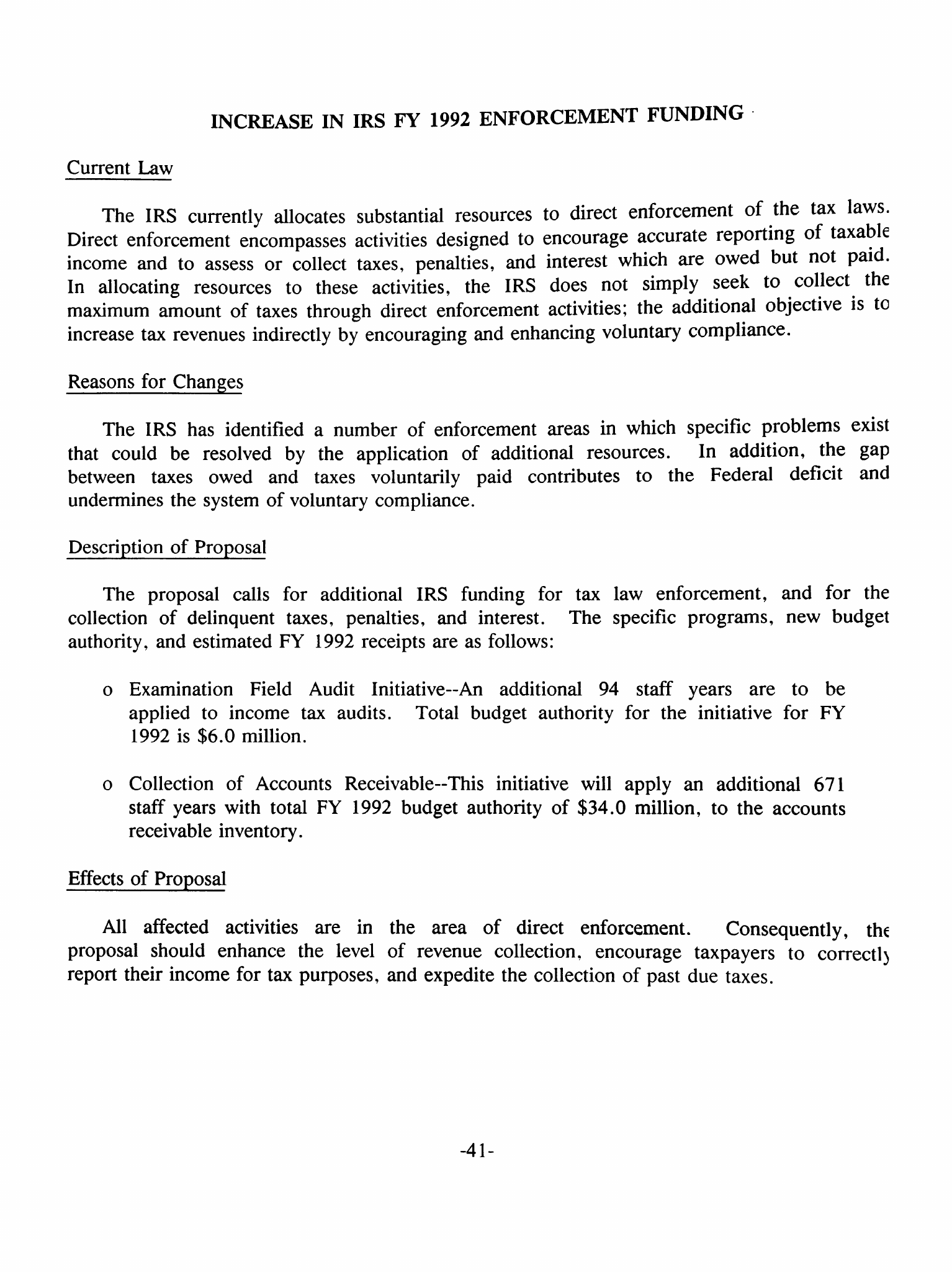
INCREASE IN IRS FY 1992 ENFORCEMENT FUNDING
Current Law
The IRS currently allocates substantial resources to direct enforcement of the tax laws.
Direct enforcement encompasses activities designed to encourage accurate reporting of taxable
income and
to
assess
or
collect taxes, penalties, and interest which are owed but not paid.
In allocating resources
to
these activities,
the IRS
does
not
simply seek
to
collect
the
maximum amount of taxes through direct enforcement activities; the additional objective is
to
increase tax revenues indirectly by encouraging and enhancing voluntary compliance.
Reasons for Changes
The IRS has identified a number of enforcement areas in which specific problems exist
that could
be
resolved
by the
application
of
additional resources.
In
addition,
the gap
between taxes owed
and
taxes voluntarily paid contributes
to the
Federal deficit
and
undermines the system of voluntary compliance.
Description of Proposal
The proposal calls for additional IRS funding for tax law enforcement, and for the
collection
of
delinquent taxes, penalties,
and
interest.
The
specific programs,
new
budget
authority, and estimated
FY
1992 receipts are as follows:
o Examination Field Audit Initiative—An additional 94 staff years are to be
applied
to
income tax audits. Total budget authority for the initiative for
FY
1992 is $6.0 million.
o Collection of Accounts Receivable-This initiative will apply an additional 671
staff years with total
FY
1992 budget authority of $34.0 million, to the accounts
receivable inventory.
Effects of Proposal
All affected activities are in the area of direct enforcement. Consequently, the
proposal should enhance
the
level
of
revenue collection, encourage taxpayers
to
correctlj
report their income for tax
purposes,
and expedite the collection of past due taxes.
-41-
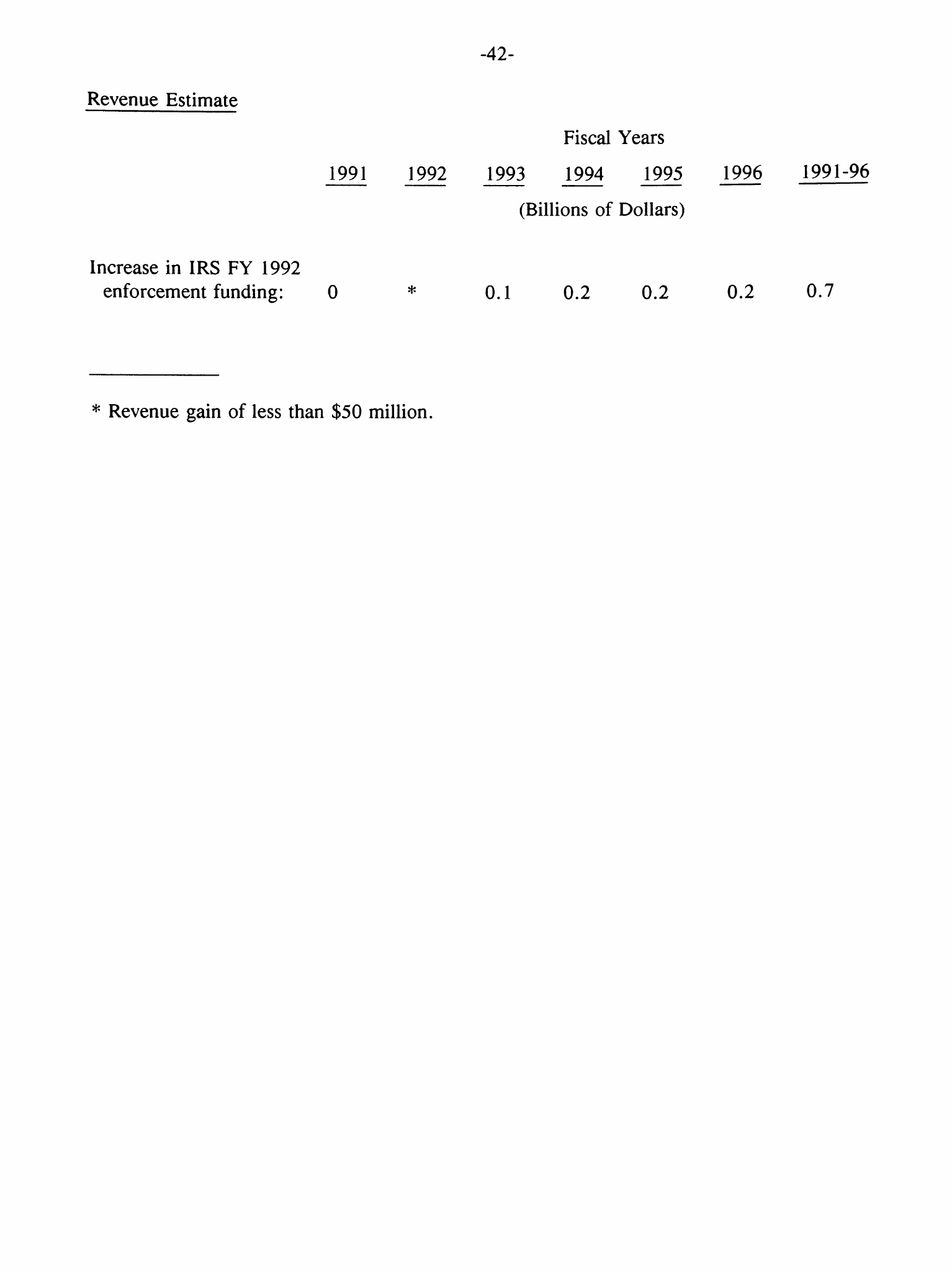
Revenue Estimate
1991
Increase in IRS FY 1992
enforcement funding: 0
-42-
Fiscal Years
1992 2993 1994 1995 1996
(Billions of Dollars)
* 0.1 0.2 0.2 0.2
* Revenue gain of
less
than $50 million.
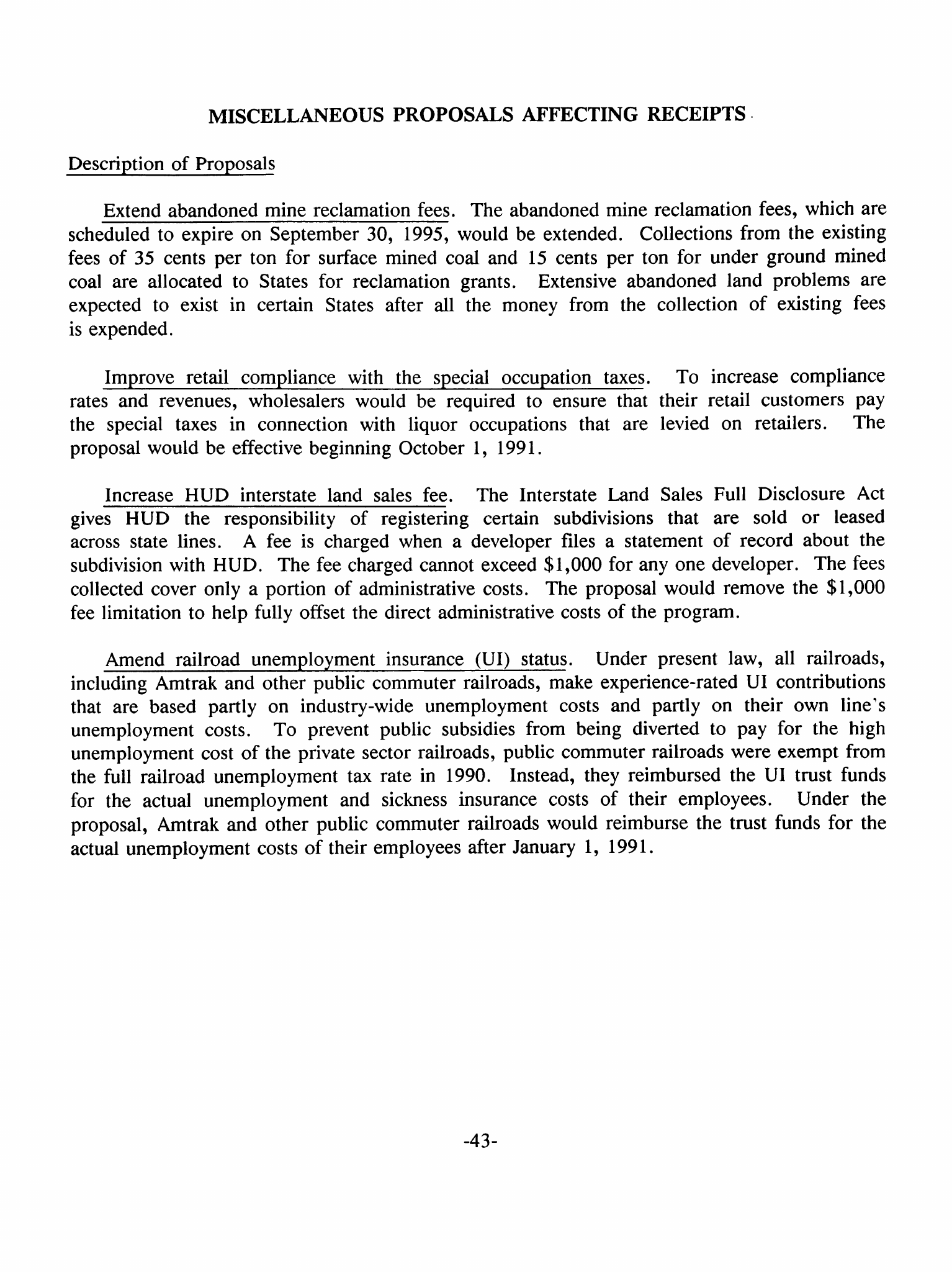
MISCELLANEOUS PROPOSALS AFFECTING RECEIPTS
Description of Proposals
Extend abandoned mine reclamation fees. The abandoned mine reclamation fees, which are
scheduled to expire
on
September 30, 1995, would be extended. Collections from the existing
fees of 35 cents per ton for surface mined coal and
15
cents per ton for under ground mined
coal are allocated
to
States for reclamation grants. Extensive abandoned land problems
are
expected
to
exist
in
certain States after all the money from the collection
of
existing fees
is expended.
Improve retail compliance with the special occupation taxes. To increase compliance
rates
and
revenues, wholesalers would
be
required
to
ensure that their retail customers
pay
the special taxes
in
connection with liquor occupations that
are
levied
on
retailers.
The
proposal would be effective beginning October 1, 1991.
Increase HUD interstate land sales fee. The Interstate Land Sales Full Disclosure Act
gives
HUD the
responsibility
of
registering certain subdivisions that
are
sold
or
leased
across state lines.
A
fee is charged when
a
developer files
a
statement of record about the
subdivision with HUD. The fee charged cannot exceed $1,000 for any one developer. The fees
collected cover only
a
portion of administrative costs. The proposal would remove the $1,000
fee limitation to help fully offset the direct administrative costs of the program.
Amend railroad unemployment insurance (UI) status. Under present law, all railroads,
including Amtrak and other public commuter railroads, make experience-rated
UI
contributions
that are based partly
on
industry-wide unemployment costs
and
partly
on
their
own
line's
unemployment costs.
To
prevent public subsidies from being diverted
to pay
for the high
unemployment cost of the private sector
railroads,
public commuter railroads were exempt from
the full railroad unemployment tax rate in 1990. Instead, they reimbursed the
UI
trust funds
for the actual unemployment
and
sickness insurance costs
of
their employees. Under
the
proposal, Amtrak and other public commuter railroads would reimburse the trust funds for the
actual unemployment costs of their employees after January 1, 1991.
-43-
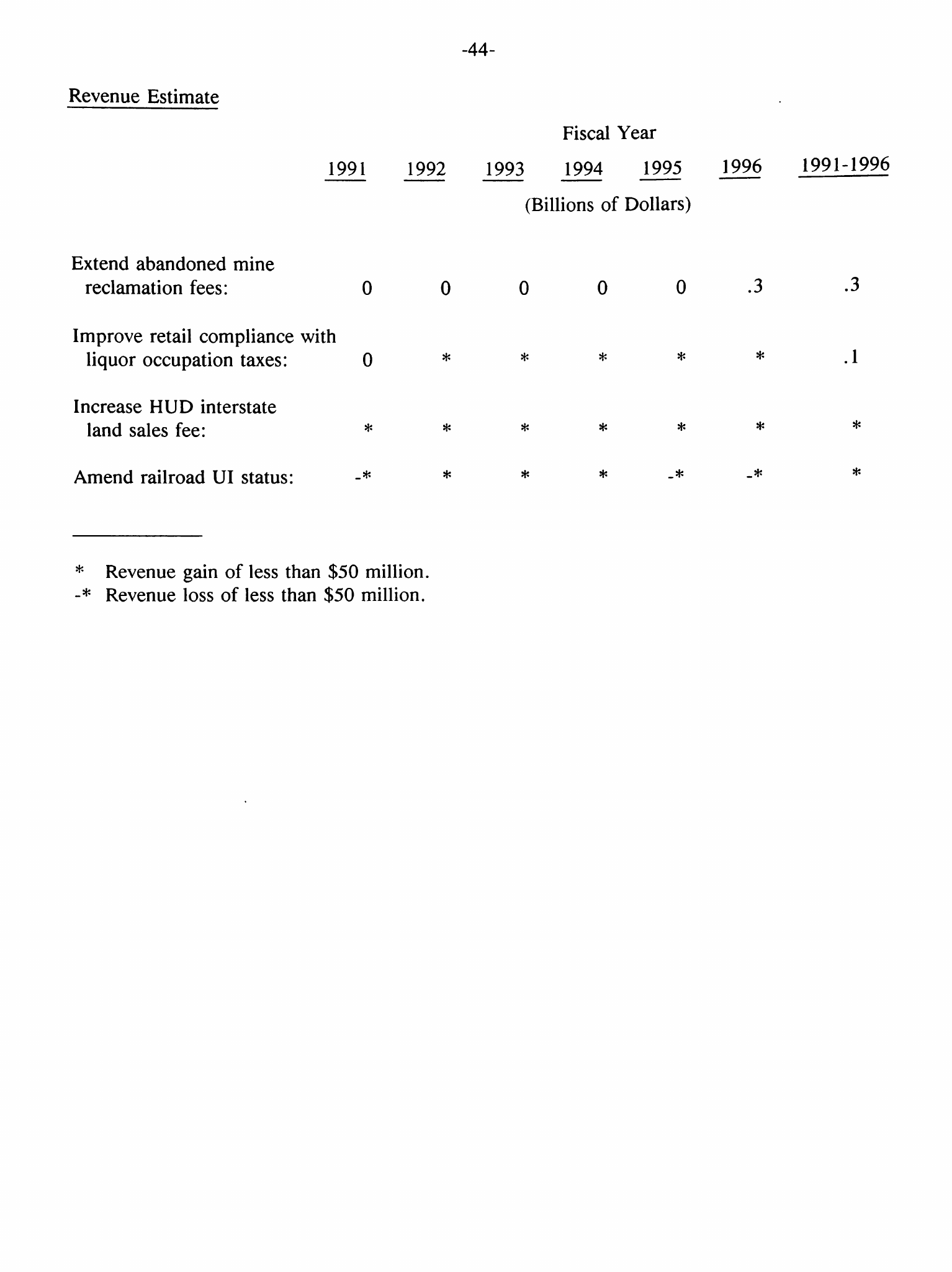
-44-
Revenue Estimate
Fiscal Year
1991 1992 1993 1994 1995 1996 1991-1996
(Billions of Dollars)
Extend abandoned mine
reclamation fees:
0
0
0
0
0
.3
.3
Improve retail compliance with
liquor occupation
taxes:
0
* *
*
*
*
.1
Increase HUD interstate
land sales fee:
* *
* *
*
*
*
Amend railroad UI status:
_*
*
* _.#
_*
*
* Revenue gain of less than $50 million.
-* Revenue loss of less than $50 million.


Department
of the
Treasury
Washington, D.C. 20220
Official Business
Penalty for Private Use, $300
